Search Result
Results for "
estrogenically active
" in MedChemExpress (MCE) Product Catalog:
13
Isotope-Labeled Compounds
| Cat. No. |
Product Name |
Target |
Research Areas |
Chemical Structure |
-
- HY-132294
-
|
|
Estrogen Receptor/ERR
|
Cancer
|
|
GNE-502 is an orally active and potent degrader for estrogen receptor (ER). GNE-502 can be used for the research of breast cancer .
|
-
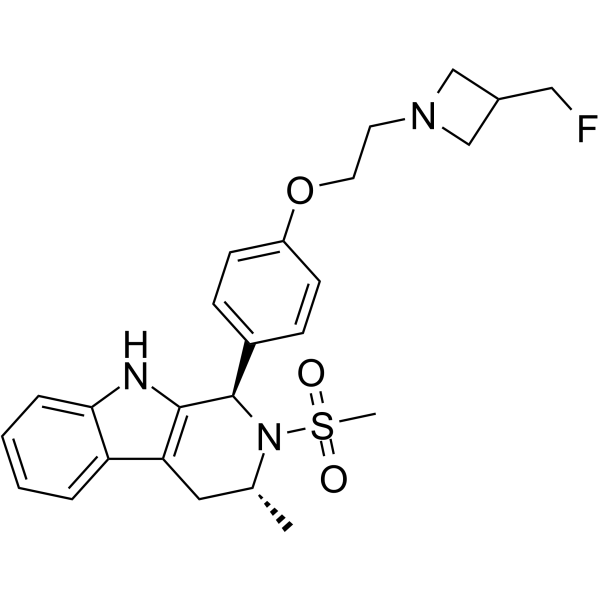
-
- HY-B0216
-
-
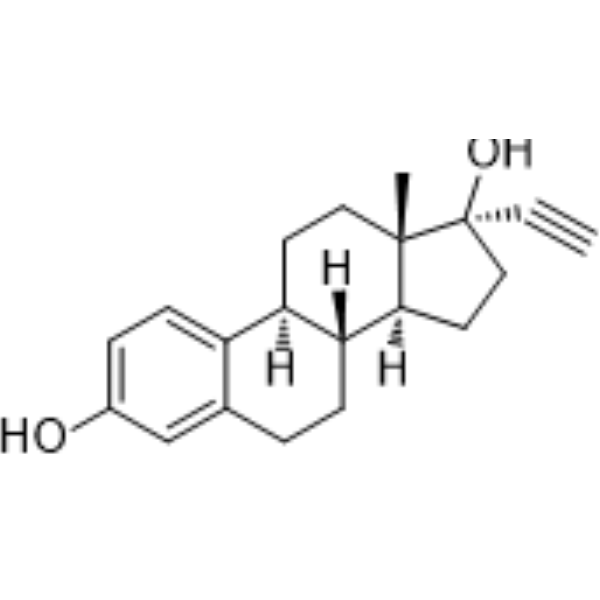
-
- HY-13738A
-
|
Keoxifene hydrochloride; LY156758; LY139481 hydrochloride
|
Estrogen Receptor/ERR
Autophagy
|
Endocrinology
Cancer
|
|
Raloxifene hydrochloride (Keoxifene hydrochloride) is a second generation selective and orally active estrogen receptor modulator. Raloxifene hydrochloride produces estrogen-agonistic effects on bone and lipid metabolism and estrogen-antagonistic effects on uterine endometrium and breast tissue .
|
-

-
- HY-W326021
-
|
|
Others
|
Endocrinology
|
|
Phenolphthalol is a laxative in agent preparations and also estrogenically active .
|
-
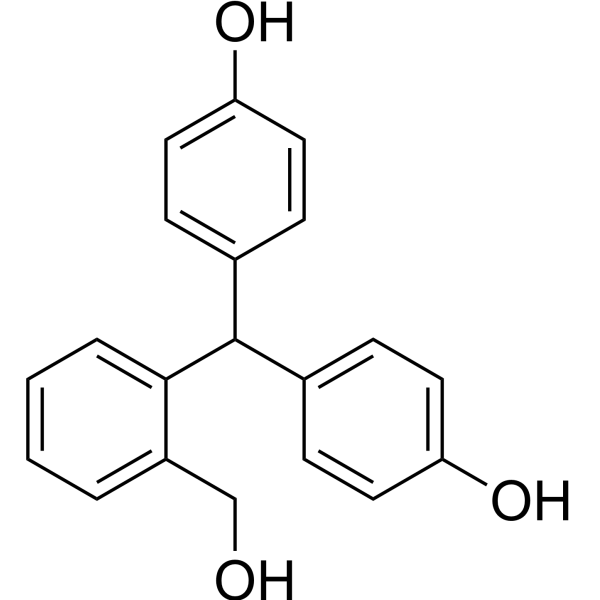
-
- HY-13556
-
|
LY353381; SERM III
|
Estrogen Receptor/ERR
|
Metabolic Disease
|
|
Arzoxifene (LY353381) is an orally active selective estrogen receptor modulator with a fixed ring structure similar to raloxifene. Arzoxifene has minimal side effects with powerful antiestrogenic effects on breast cancer and endometrium, with equally strong favorable estrogenic effects on bone and lipid profile .
|
-
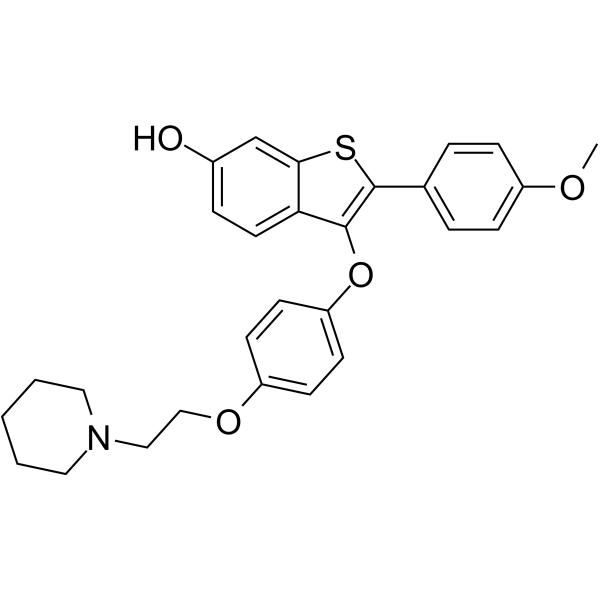
-
- HY-113293B
-
|
|
Estrogen Receptor/ERR
Endogenous Metabolite
|
Cancer
|
|
Estrone sulfate, a biologically inactive form of estrogen, is a major circulating plasma estrogen that is converted into the biologically active estrogen, estrone (E1) by steroid sulfatase (STS). Estrone sulfate can be used for the research of breast cancer .
|
-
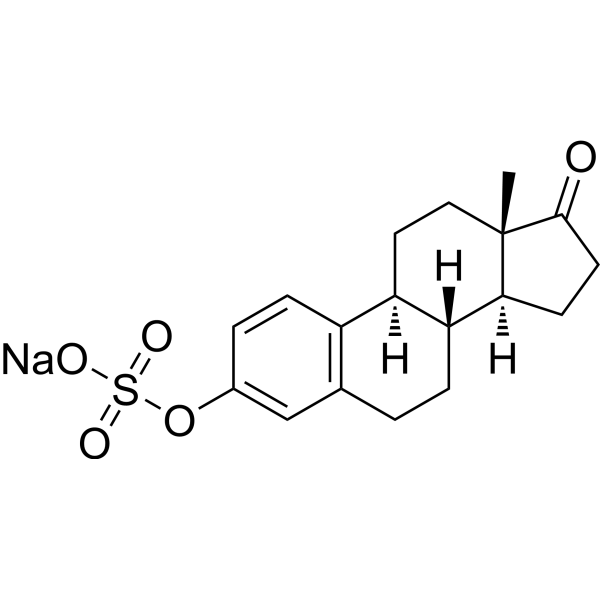
-
- HY-110201
-
|
|
Estrogen Receptor/ERR
|
Cancer
|
|
Estrogen receptor modulator 1 (compound 18) is an orally active and selective estrogen receptor modulator (SERM), with a pIC50 of 0.46. Estrogen receptor modulator 1 induces regression of Tamoxifen-resistant, hormone independent xenograft tumors .
|
-
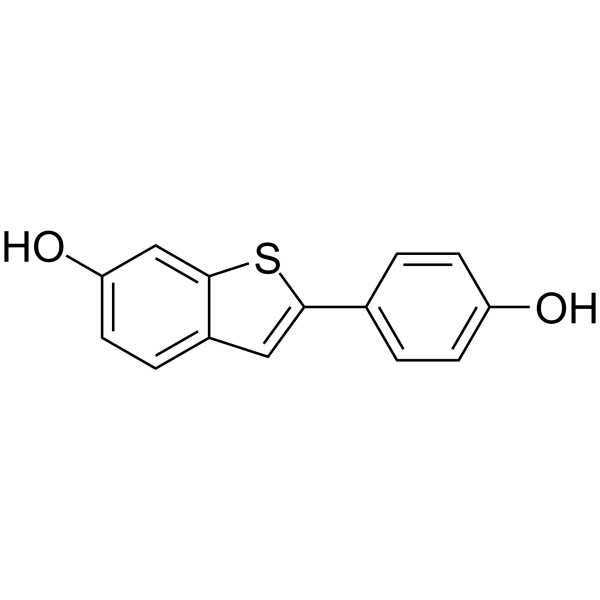
-
- HY-W587691
-
-
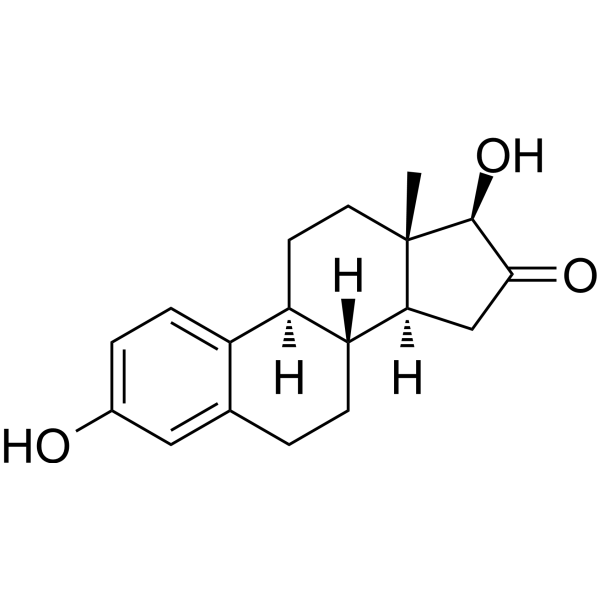
-
- HY-13738AR
-
|
Keoxifene (hydrochloride)(Standard); LY156758(Standard); LY139481 hydrochloride (Standard)
|
Estrogen Receptor/ERR
Autophagy
|
Endocrinology
Cancer
|
|
Raloxifene (hydrochloride) (Standard) is the analytical standard of Raloxifene (hydrochloride). This product is intended for research and analytical applications. Raloxifene hydrochloride (Keoxifene hydrochloride) is a second generation?selective and orally active estrogen receptor modulator. Raloxifene hydrochloride produces estrogen-agonistic effects on bone and lipid metabolism and estrogen-antagonistic effects on uterine endometrium and breast tissue .
|
-
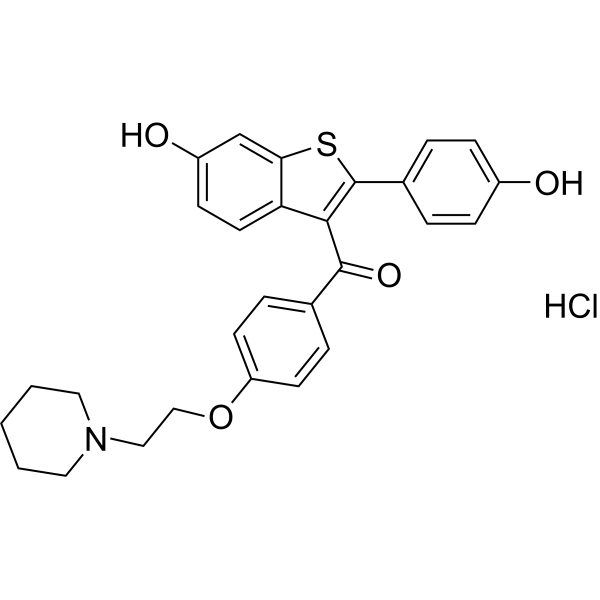
-
- HY-153700
-
|
|
Estrogen Receptor/ERR
|
Endocrinology
|
|
Estrogen receptor modulator 8 (compound 4) is an orally active inhibitor of Estrogen Receptor/ERR α (IC50=0.437 nM, MCF-7 cells). Estrogen receptor modulator 8 inhibits MCF-7 cells proliferation with an IC50 value of 0.1 nM .
|
-
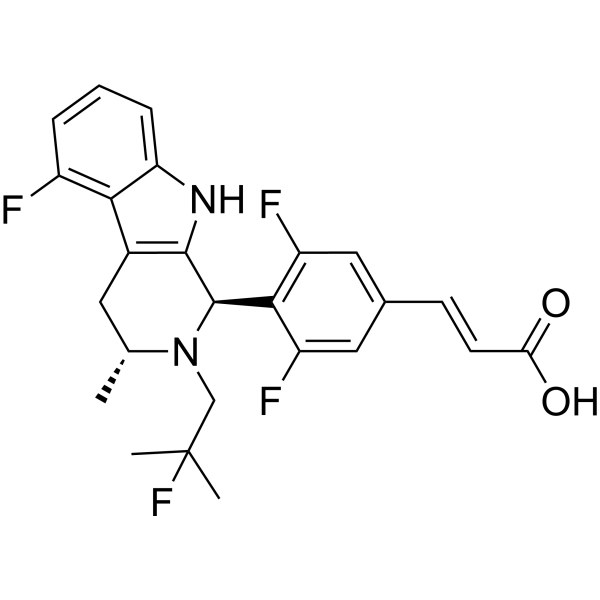
-
- HY-113293BS
-
|
|
Estrogen Receptor/ERR
Endogenous Metabolite
|
Cancer
|
|
Estrone sulfate-d5 (sodium) is the deuterium labeled Estrone sulfate sodium. Estrone sulfate, a biologically inactive form of estrogen, is a major circulating plasma estrogen that is converted into the biologically active estrogen, estrone (E1) by steroid sulfatase (STS). strone sulfate can be used for the research of breast cancer[1][2].
|
-
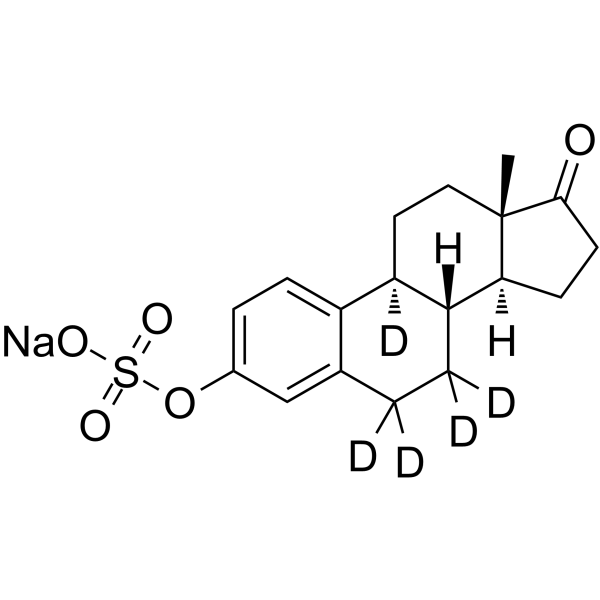
-
- HY-113293BS1
-
|
|
Estrogen Receptor/ERR
Endogenous Metabolite
|
Cancer
|
|
Estrone sulfate-d4 (sodium) is deuterium labeled Estrone sulfate (sodium). Estrone sulfate, a biologically inactive form of estrogen, is a major circulating plasma estrogen that is converted into the biologically active estrogen, estrone (E1) by steroid sulfatase (STS). strone sulfate can be used for the research of breast cancer[1][2].
|
-
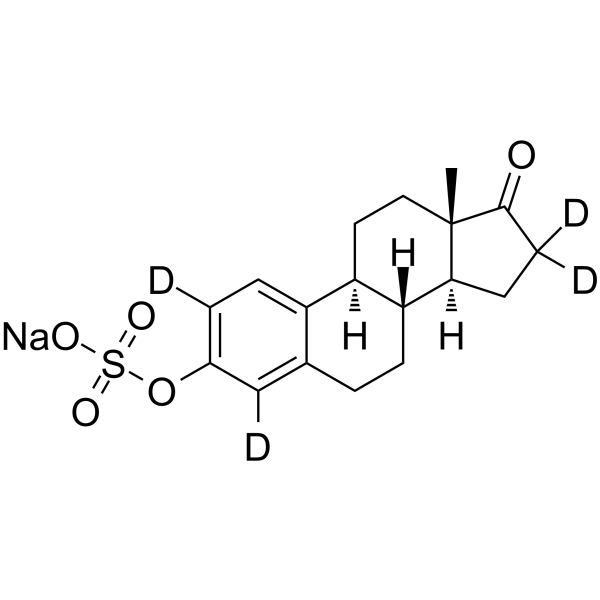
-
- HY-B2158
-
|
|
|
|
|
Chlorotrianisene is a long-acting non-steroidal estrogen and an orally active estrogen receptor modulator. Chlorotrianisene exhibits antiestrogenic activity. Chlorotrianisene potently inhibits the enzyme COX-1 and inhibits platelet aggregation in whole blood .
|
-
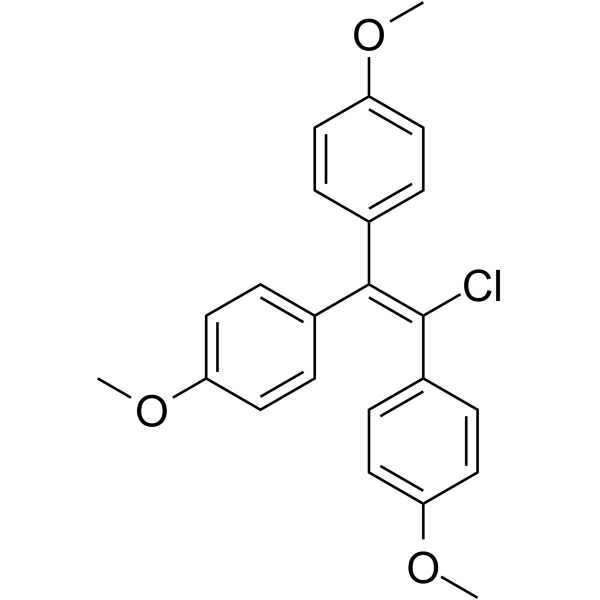
-
- HY-149969
-
|
|
Estrogen Receptor/ERR
|
Cancer
|
|
ER degrader 4 is a selective and orally active estrogen receptor degrader. ER degrader 4 has anti-tumor activity .
|
-
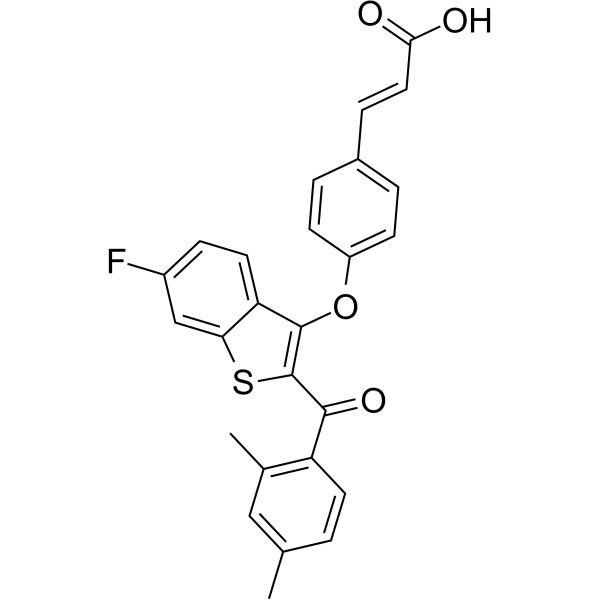
-
- HY-16950B
-
|
(E)-Afimoxifene
|
Estrogen Receptor/ERR
|
Cancer
|
|
(E)-4-Hydroxytamoxifen ((E)-Afimoxifene), the less active isomer of (Z)-4-hydroxytamoxifen, is an estrogen receptor modulator.
|
-
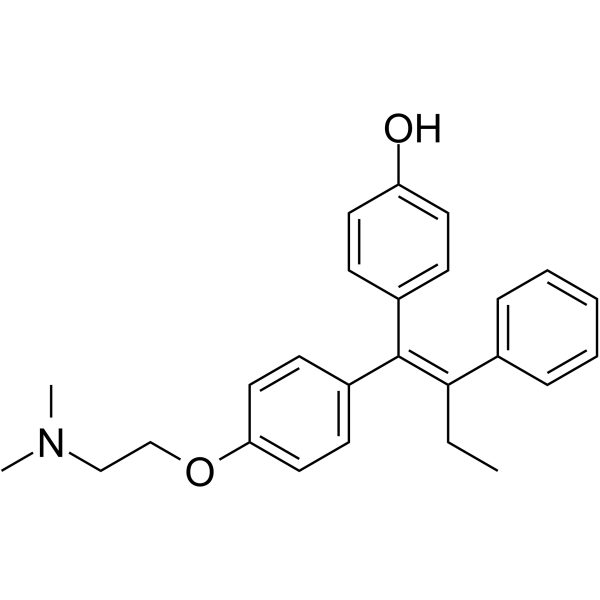
-
- HY-B2158S
-
|
|
Estrogen Receptor/ERR
COX
|
Cardiovascular Disease
Endocrinology
|
|
Chlorotrianisene-d9 is the deuterium labeled Chlorotrianisene. Chlorotrianisene is a long-acting non-steroidal estrogen and an orally active estrogen receptor modulator. Chlorotrianisene exhibits antiestrogenic activity. Chlorotrianisene potently inhibits the enzyme COX-1 and inhibits platelet aggregation in whole blood[1][2][3].
|
-
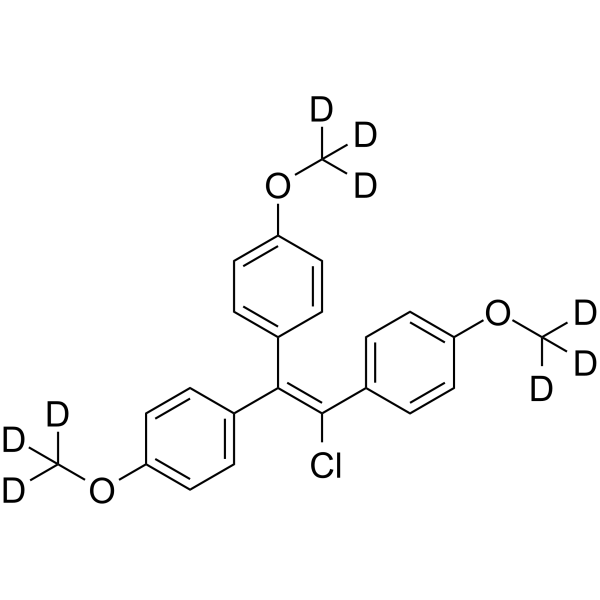
-
- HY-14247B
-
|
CGS 16949A hemihydrate; (Rac)-FAD286 hydrochloride hemihydrate
|
Cytochrome P450
|
Endocrinology
Cancer
|
|
Fadrozole hydrochloride hemihydrate is an orally active, potent, selective and nonsteroidal aromatase inhibitor, with an IC50 of 6.4 nM. Fadrozole hydrochloride hemihydrate inhibits the production of estrogen and progesterone, with IC50 values of 0.03 and 120 μM. Fadrozole hydrochloride hemihydrate shows prevention of spontaneous tumours. Fadrozole hydrochloride hemihydrate can be used for the research of estrogen-dependent disease and cancer .
|
-
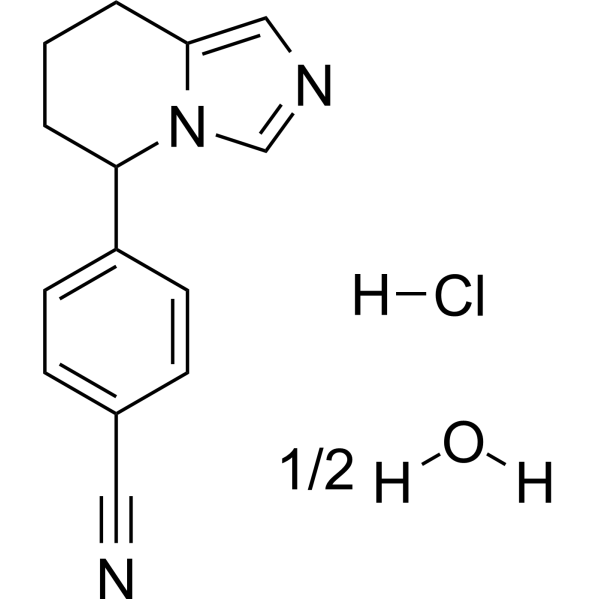
-
- HY-B0723S
-
|
FC-1271a d4
|
Estrogen Receptor/ERR
|
Cancer
|
|
Ospemifene-d4 is a deuterium labeled Ospemifene. Ospemifene is a selective and orally active estrogen receptor modulator for the prevention of osteoporosis with IC50 values of 827 nM and 1633 nM for estrogen receptor α (ERα) and ERβ, respectively. Ospemifene has bone-sparing, antitumor, and cholesterol-lowering effects[1][2].
|
-
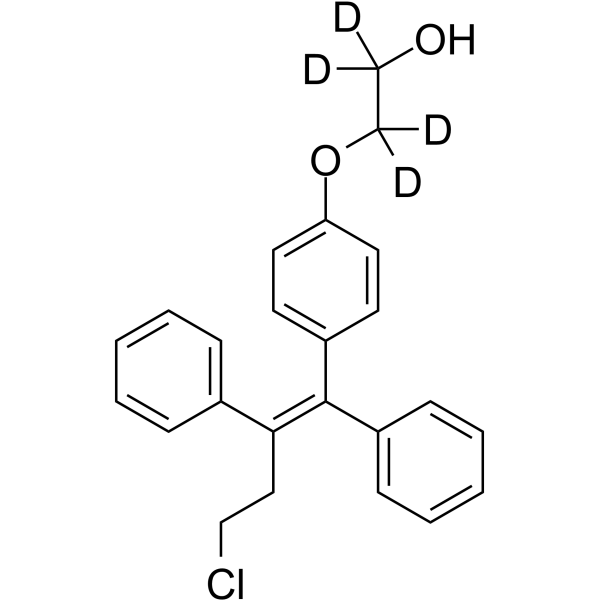
-
- HY-138642
-
|
ARV-471
|
PROTACs
Estrogen Receptor/ERR
|
Cancer
|
|
Vepdegestrant (ARV-471) is an orally active PROTAC estrogen receptor degrader against breast cancer. Vepdegestrant is a hetero-bifunctional molecule that facilitates the interactions between estrogen receptor alpha and an intracellular E3 ligase complex. Vepdegestrant leads to the ubiquitylation and subsequent degradation of estrogen receptors via the proteasome. Vepdegestrant robustly degrades ER in ER-positive breast cancer cell lines with a half-maximal degradation concentration (DC50) of about 2 nM .
|
-
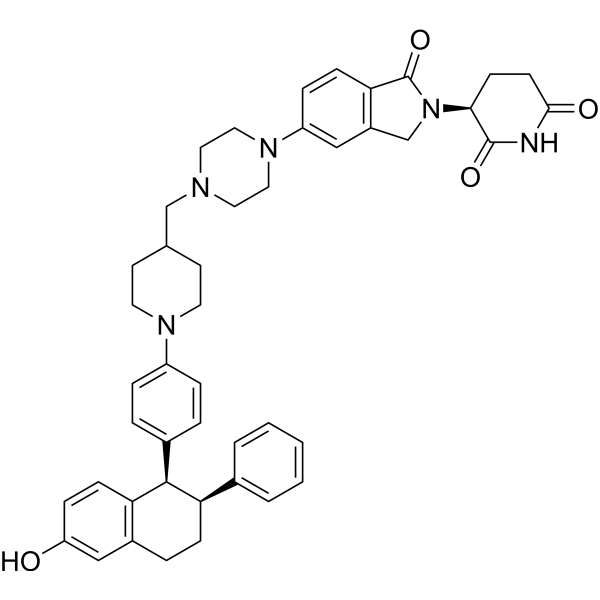
-
- HY-B0412
-
Estriol
3 Publications Verification
Oestriol
|
Estrogen Receptor/ERR
Endogenous Metabolite
|
Cancer
|
|
Estriol (Oestriol), an orally active estrogen, is a ERα and ERβ agonist. Estriol is a potent GPR30 antagonist in estrogen receptor-negative breast cancer cells. Estriol can ameliorate disease severity through immunomodulatory mechanisms that decrease tissue inflammation. Estriol has powerful proconvulsant effects .
|
-
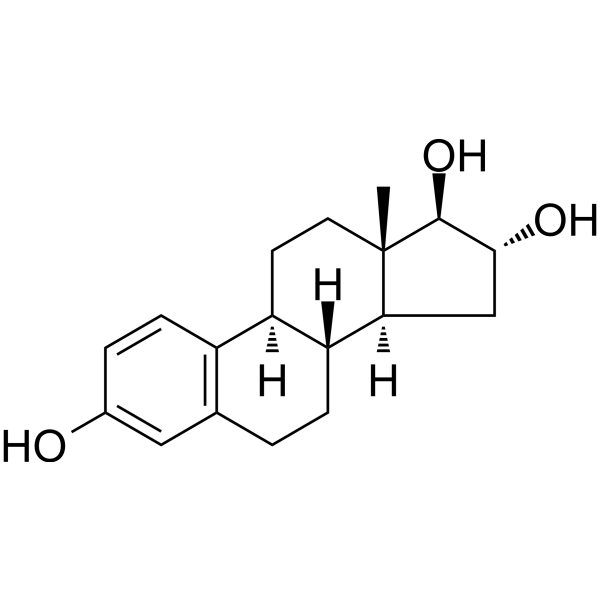
-
- HY-101119
-
|
|
|
|
|
GLL398, an orally active selective estrogen receptor degrader (SERD), competitively binds to the estrogen receptor with an IC50 value of 1.14 nM. GLL398 exhibits a strong dose-dependent binding profile for the ER with a Y537S point mutation (IC50= 29.5 nM). GLL398 blocks tumor growth in xenograft breast cancer models .
|
-
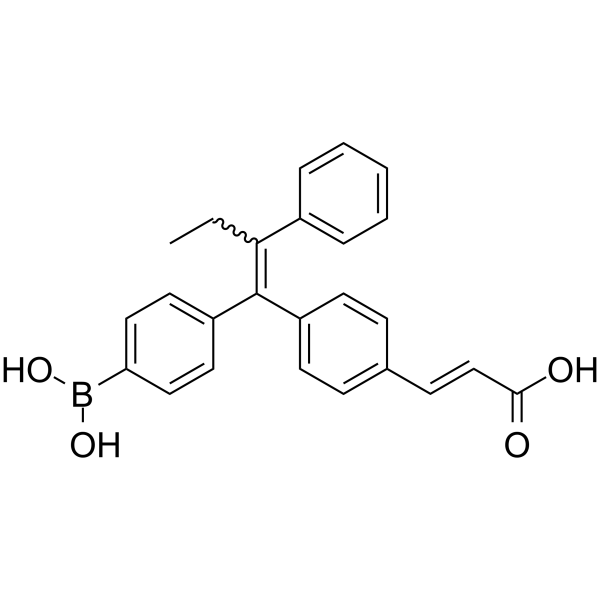
-
- HY-126109
-
|
|
Estrogen Receptor/ERR
Apoptosis
|
Metabolic Disease
Endocrinology
Cancer
|
|
(±)-8-Prenylnaringenin, a natural prenylated flavonoid, is a potent phytoestrogen. (±)-8-Prenylnaringenin is an orally active selective estrogen receptor modulator (SERM) (Estrogen Receptor/ERR) that inhibits ERα and ERβ with IC50s of 57 nM and 68 nM, respectively. (±)-8-Prenylnaringenin has anticancer effects, and can be used for osteoporosis research .
|
-

-
- HY-18719B
-
-
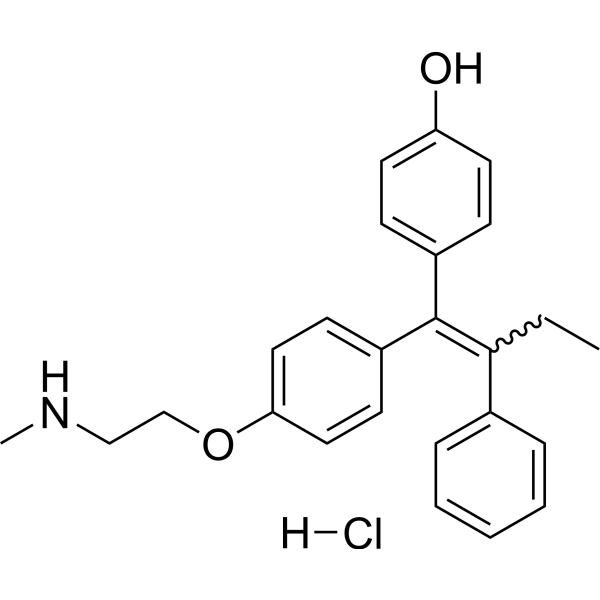
-
- HY-18719E
-
-
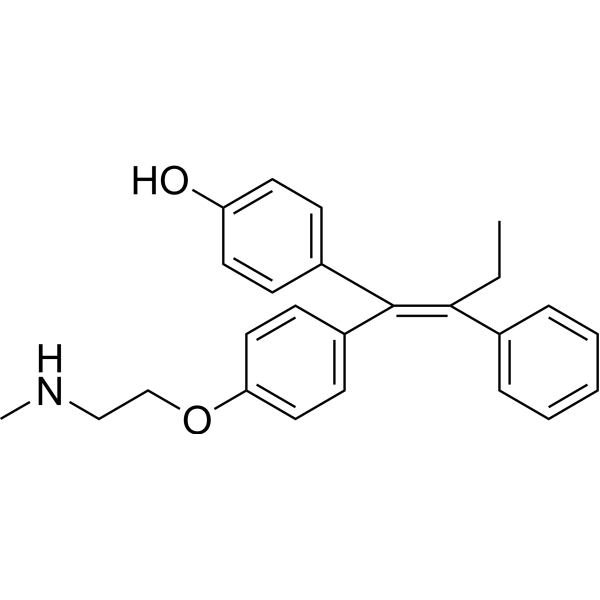
-
- HY-136255
-
|
AZD-9833
|
Estrogen Receptor/ERR
|
Cancer
|
|
Camizestrant (AZD-9833) is a potent and orally active estrogen receptor (ER) antagonist. Camizestrant is used for the study of ER + HER2-advanced breast cancer .
|
-
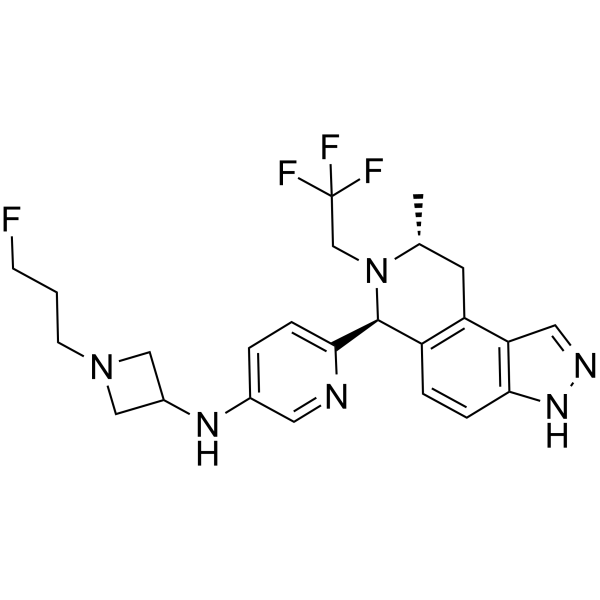
-
- HY-137449
-
|
G1T48
|
Estrogen Receptor/ERR
CDK
|
Cancer
|
|
Rintodestrant (G1T48) is an orally active, non-steroidal and selective estrogen receptor degrader. Rintodestrant (G1T48) is also a CDK4/6 inhibitor .
|
-
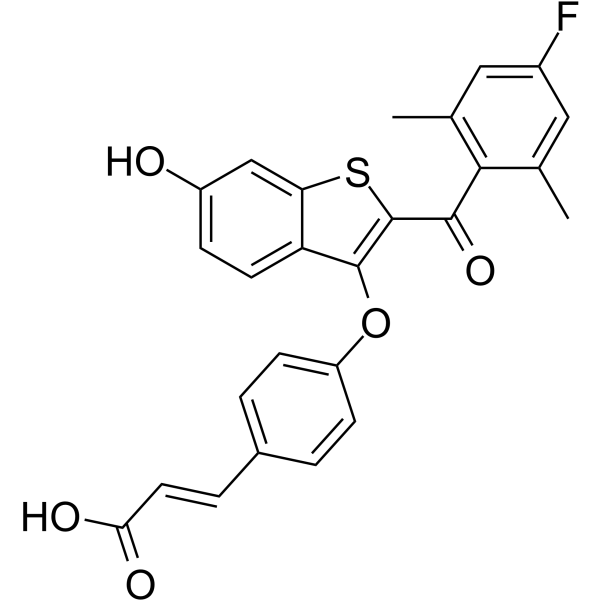
-
- HY-147402
-
|
D-0502
|
Estrogen Receptor/ERR
|
Cancer
|
|
Taragarestrant (D-0502) is a potent, orally active and selective estrogen receptor degrader (SERD). Taragarestrant shows potent activity in various ER+ breast cancer cell lines and xenograft models .
|
-
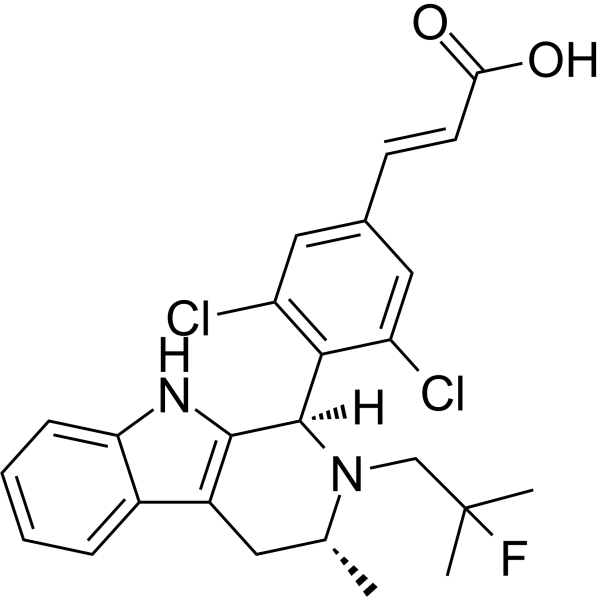
-
- HY-118861
-
|
(E)-Clomiphene; trans-Clomiphene; Enclomifene
|
Estrogen Receptor/ERR
|
Metabolic Disease
Endocrinology
|
|
Enclomiphene ((E)-Clomiphene) is a potent and orally active non-steroidal estrogen receptor antagonist, with antioestrogenic property. Enclomiphene can be used for the research of ovarian dysfunction, testosterone deficiency, male hypogonadism and type 2 diabetes .
|
-
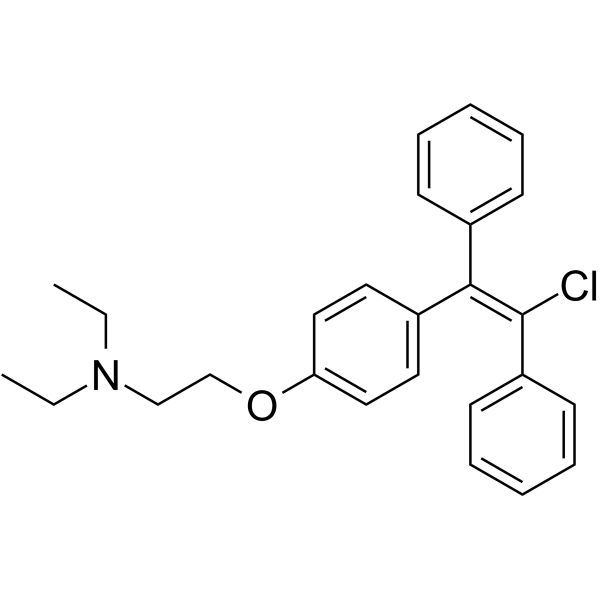
-
- HY-118861B
-
|
(E)-Clomiphene hydrochloride; trans-Clomiphene hydrochloride; Enclomifene hydrochloride
|
Estrogen Receptor/ERR
|
Metabolic Disease
Endocrinology
|
|
Enclomiphene ((E)-Clomiphene) hydrochloride is a potent and orally active non-steroidal estrogen receptor antagonist, with antioestrogenic property. Enclomiphene hydrochloride can be used for the research of ovarian dysfunction, testosterone deficiency, male hypogonadism and type 2 diabetes .
|
-
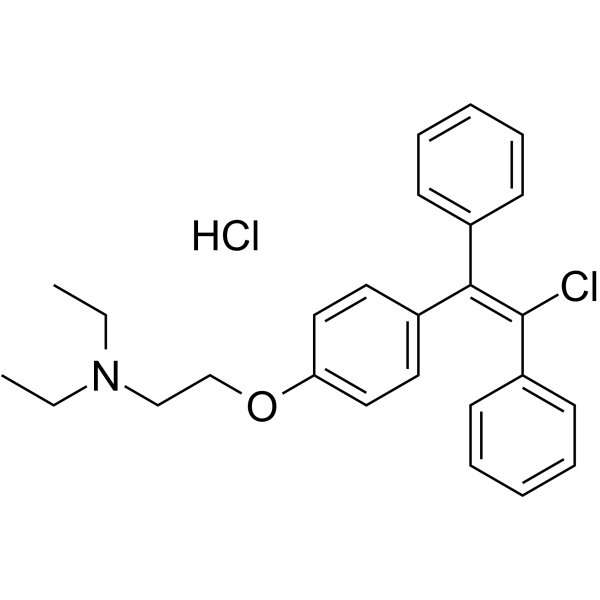
-
- HY-14248
-
|
CGS 20267
|
Cytochrome P450
Autophagy
|
Cancer
|
|
Letrozole (CGS 20267) is a potent, selective, reversible and orally active non-steroidal inhibitor of aromatase, with an IC50 of 11.5 nM. Letrozole selective inhibits estrogen biosynthesis, and can be used for the research of breast cancer .
|
-
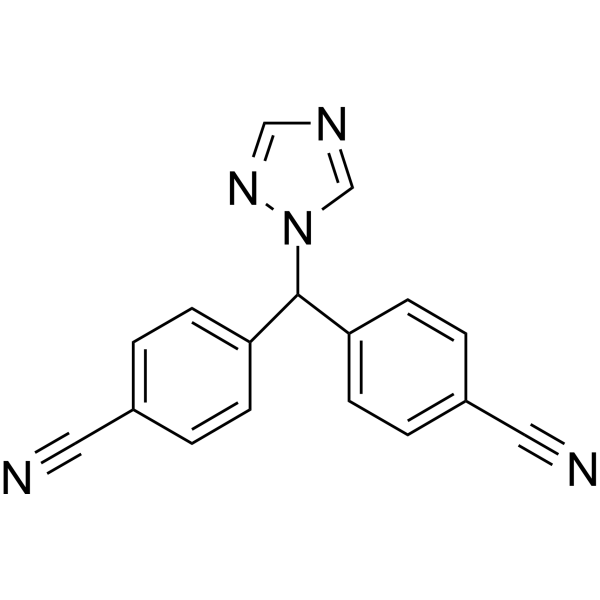
-
- HY-13702
-
|
Nilandron; RU 23908
|
Androgen Receptor
Parasite
|
Infection
Endocrinology
Cancer
|
|
Nilutamide (Nilandron) is an orally active nonsteroidal androgen receptor antagonist with affinity for androgen receptors but not for progestogen, estrogen or glucocorticoid receptors. Nilutamide can be used to research prostate cancer. Nilutamide also has antischistosomal properties .
|
-

-
- HY-19498
-
|
SIM-688
|
|
|
|
WAY-204688 is an estrogen receptor (ER-α) selective, orally active inhibitor of NF-κB transcriptional activity with an IC50 of 122 ± 30 nM for NF-κB-luciferase (NF-κB-luc) in HAECT-1 cells.
|
-
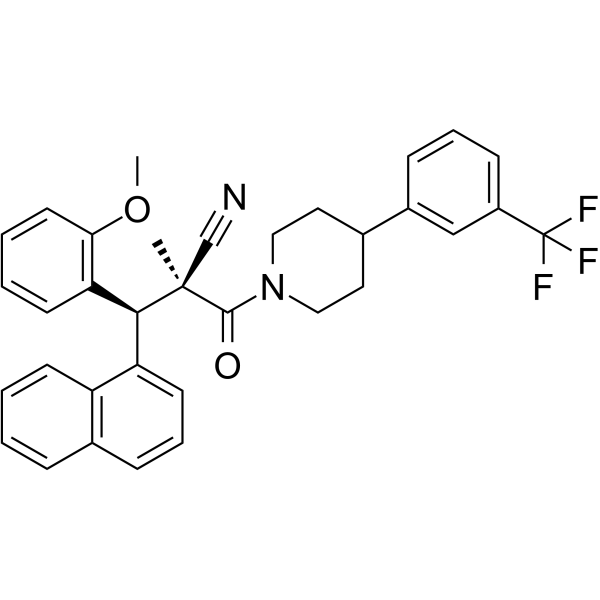
-
- HY-147402A
-
|
D-0502 meglumine
|
Estrogen Receptor/ERR
|
Cancer
|
|
Taragarestrant (D-0502) meglumine is a potent, orally active and selective estrogen receptor degrader (SERD). Taragarestrant meglumine shows potent activity in various ER+ breast cancer cell lines and xenograft models .
|
-
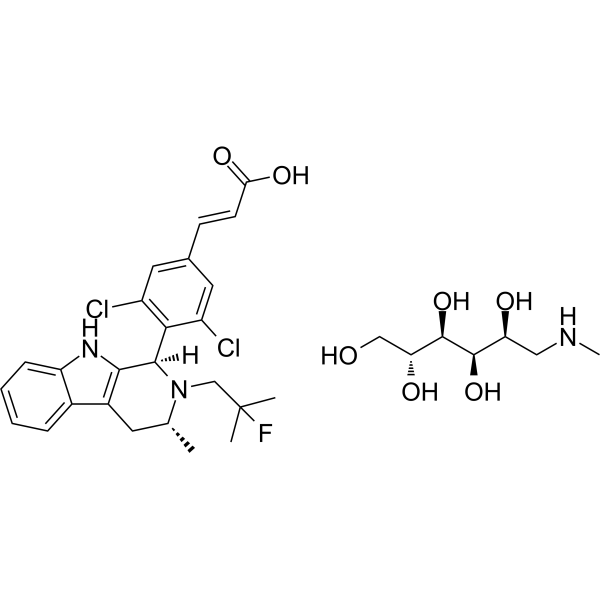
-
- HY-13757A
-
Tamoxifen
Maximum Cited Publications
83 Publications Verification
ICI 47699; (Z)-Tamoxifen; trans-Tamoxifen
|
Estrogen Receptor/ERR
HSP
Autophagy
Apoptosis
|
Cancer
|
|
Tamoxifen (ICI 47699) is an orally active, selective estrogen receptor modulator (SERM) which blocks estrogen action in breast cells and can activate estrogen activity in other cells, such as bone, liver, and uterine cells . Tamoxifen is a potent Hsp90 activator and enhances the Hsp90 molecular chaperone ATPase activity. Tamoxifen also potent inhibits infectious EBOV Zaire and Marburg (MARV) with IC50 of 0.1 µM and 1.8 µM, respectively . Tamoxifen activates autophagy and induces apoptosis . Tamoxifen also can induce gene knockout of CreER(T2) transgenic mouse .
|
-

-
- HY-118861A
-
|
(E)-Clomiphene citrate; trans-Clomiphene citrate; Enclomifene citrate
|
Estrogen Receptor/ERR
|
Metabolic Disease
Endocrinology
|
|
Enclomiphene ((E)-Clomiphene) citrate is a potent and orally active non-steroidal estrogen receptor antagonist, with antioestrogenic property. Enclomiphene citrate can be used for the research of ovarian dysfunction, testosterone deficiency, male hypogonadism and type 2 diabetes .
|
-
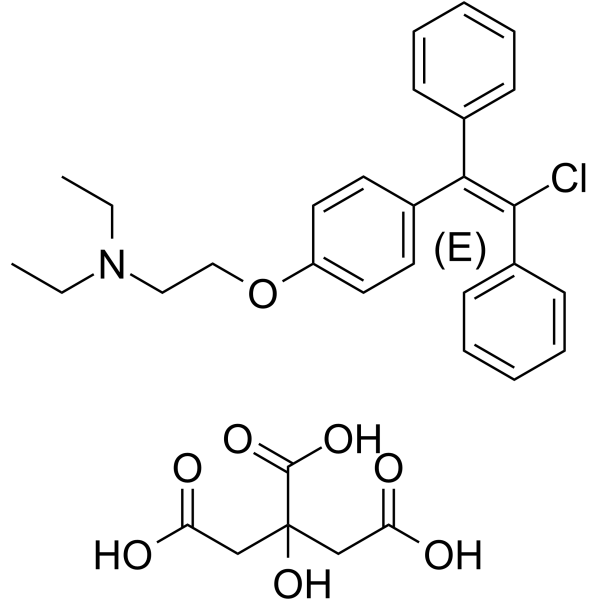
-
- HY-B0463
-
|
Clomifene citrate
|
Estrogen Receptor/ERR
|
Neurological Disease
Endocrinology
Cancer
|
|
Clomiphene citrate (Clomifene citrate) is an orally active estrogen-receptor modulator. Clomiphene citrate has anti-cancer actixity, induces perturbations during meiotic maturation and cytogenetic abnormalities and ameliorates in managing psychiatric and cognitive impairment .
|
-
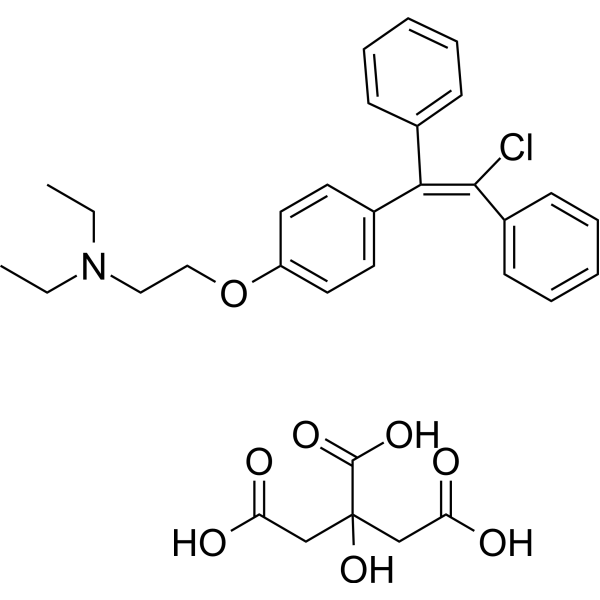
-
- HY-150542
-
|
|
Steroid Sulfatase
|
Cancer
|
|
Steroid sulfatase -IN-2 is an active steroid sulfatase (STS) inhibitor with an IC50 value of 109.5 nM. Steroid sulfatase-IN-2 can be used for the research of hormone-dependent cancers, such as estrogen-dependent breast and endometrial cancer .
|
-
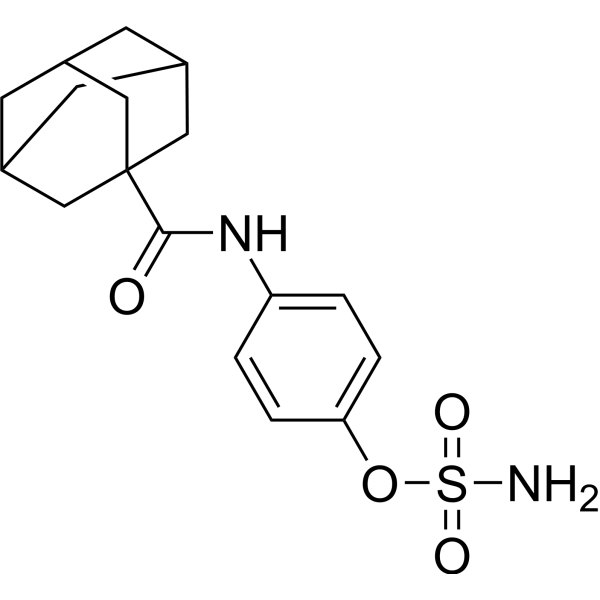
-
- HY-18719ES
-
|
|
Cytochrome P450
Estrogen Receptor/ERR
Drug Metabolite
Parasite
|
Cancer
|
|
Endoxifen-d5 is the deuterium labeled Endoxifen. Endoxifen is a key active metabolite of tamoxifen (TAM) with higher affinity and specificity to estrogen receptor that also inhibits aromatase activity. Endoxifen has the potential for breast cancer study[1][2].
|
-

-
- HY-13757AS
-
|
ICI 47699-d5; (Z)-Tamoxifen-d5; trans-Tamoxifen-d5
|
Estrogen Receptor/ERR
HSP
Autophagy
Apoptosis
|
Cancer
|
|
Tamoxifen-d5 is a deuterium labeled Tamoxifen. Tamoxifen (ICI 47699) is an orally active, selective estrogen receptor modulator (SERM). Tamoxifen is a potent Hsp90 activator and enhances the Hsp90 molecular chaperone ATPase activity[1][2].
|
-

-
- HY-A0037
-
|
CP-336156
|
Estrogen Receptor/ERR
|
Inflammation/Immunology
Cancer
|
|
Lasofoxifene (CP-336156) is an orally active and selective estrogen receptor modulator (SERM). Lasofoxifene exhibits an anti-osteoporotic function and also inhibits primary tumor growth and metastases. Lasofoxifene can be used for research of breast cancer and postmenopausal osteoporosis .
|
-
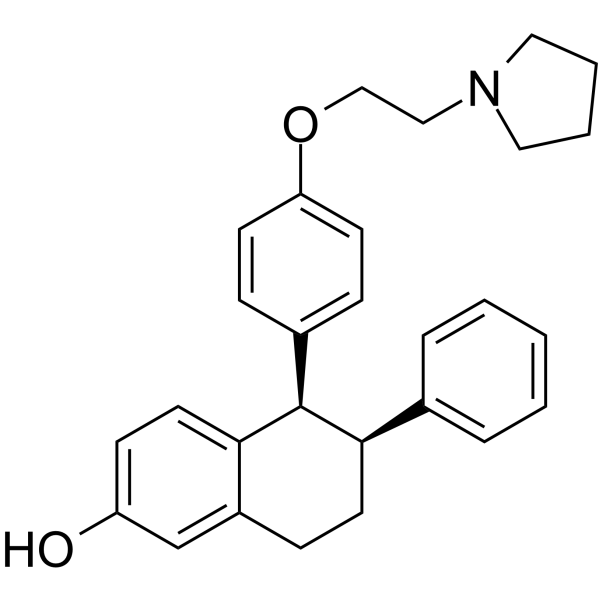
-
- HY-13757
-
|
ICI 46474; (Z)-Tamoxifen Citrate; trans-Tamoxifen Citrate
|
Estrogen Receptor/ERR
HSP
Autophagy
Apoptosis
|
Cancer
|
|
Tamoxifen Citrate (ICI 46474) is an orally active, selective estrogen receptor modulator (SERM) which blocks estrogen action in breast cells and can activate estrogen activity in other cells, such as bone, liver, and uterine cells .Tamoxifen Citrate is a potent Hsp90 activator and enhances the Hsp90 molecular chaperone ATPase activity. Tamoxifen Citrate also potent inhibits infectious EBOV Zaire and Marburg (MARV) with IC50 of 0.1 µM and 1.8 µM, respectively . Tamoxifen Citrate activates autophagy and induces apoptosis .Tamoxifen Citrate also can induce gene knockout of CreER(T2) transgenic mouse .
|
-
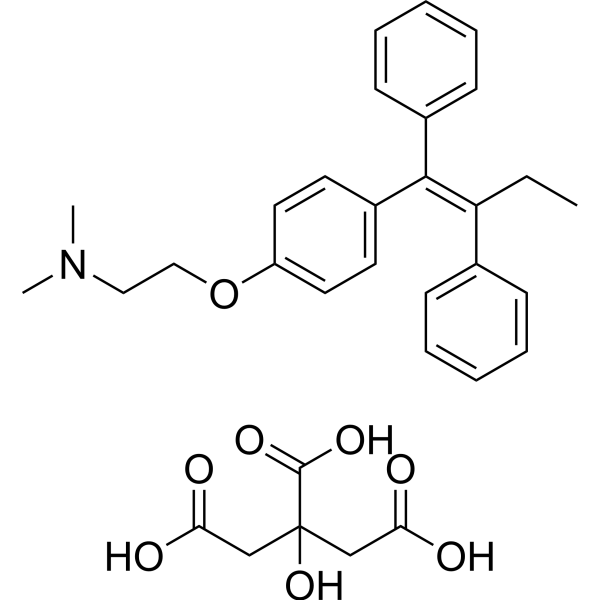
-
- HY-121149
-
|
3-Hydroxytamoxifen
|
Estrogen Receptor/ERR
Apoptosis
|
Cancer
|
|
Droloxifene, a Tamoxifen derivative, is an orally active and selective estrogen receptor modulator. Droloxifene shows antiestrogenic and anti-implantation effects. Droloxifene induces p53 expression and apoptosis in MCF-7 cells. Droloxifene prevents bone loss in ovariectomized rats .
|
-
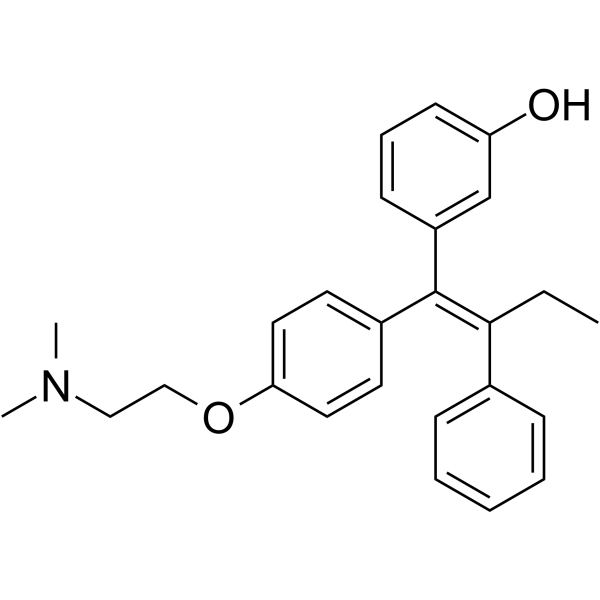
-
- HY-109176
-
|
GDC-9545; RG6171
|
Estrogen Receptor/ERR
|
Cancer
|
|
Giredestrant (GDC-9545), a non-steroidal estrogen receptor (ER) ligand, is an orally active and selective ER antagonist. Giredestrant potently competes with Estradiol for binding and induces a conformational change within the ER ligand binding domain. Giredestrant has anti-tumor activity .
|
-
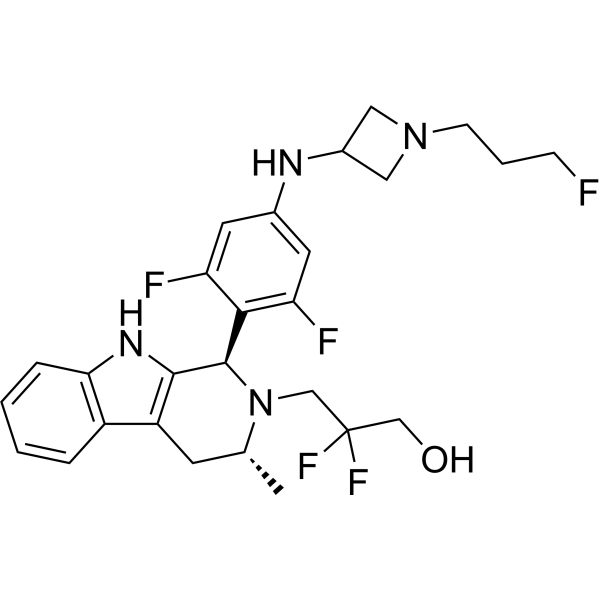
-
- HY-13757AS1
-
|
ICI 47699-d3; (Z)-Tamoxifen-d3; trans-Tamoxifen-d3
|
Estrogen Receptor/ERR
Apoptosis
Autophagy
HSP
|
Cancer
|
|
Tamoxifen-d3 is the deuterium labeled Tamoxifen[1]. Tamoxifen (ICI 47699) is an orally active, selective estrogen receptor modulator (SERM) which blocks estrogen action in breast cells and can activate estrogen activity in other cells, such as bone, liver, and uterine cells[2][3][4]. Tamoxifen is a potent Hsp90 activator and enhances the Hsp90 molecular chaperone ATPase activity. Tamoxifen also potent inhibits infectious EBOV Zaire and Marburg (MARV) with IC50 of 0.1 μM and 1.8 μM, respectively[6]. Tamoxifen activates autophagy and induces apoptosis[5]. Tamoxifen also can induce gene knockout of CreER(T2) transgenic mouse[7].
|
-

-
- HY-13757AR
-
|
ICI 47699(Standard); (Z)-Tamoxifen(Standard); trans-Tamoxifen (Standard)
|
Estrogen Receptor/ERR
HSP
Autophagy
Apoptosis
|
Cancer
|
|
Tamoxifen (Standard) is the analytical standard of Tamoxifen. This product is intended for research and analytical applications. Tamoxifen (ICI 47699) is an orally active, selective estrogen receptor modulator (SERM) which blocks estrogen action in breast cells and can activate estrogen activity in other cells, such as bone, liver, and uterine cells . Tamoxifen is a potent Hsp90 activator and enhances the Hsp90 molecular chaperone ATPase activity. Tamoxifen also potent inhibits infectious EBOV Zaire and Marburg (MARV) with IC50 of 0.1 μM and 1.8 μM, respectively . Tamoxifen activates autophagy and induces apoptosis . Tamoxifen also can induce gene knockout of CreER(T2) transgenic mouse .
|
-

-
- HY-135903
-
|
GDC-9545 tartrate; RG6171 tartrate
|
Estrogen Receptor/ERR
|
Cancer
|
|
Giredestrant tartrate (GDC-9545 tartrate), a non-steroidal ER ligand, is an orally active and selective estrogen receptor (ER) antagonist. Giredestrant tartrate potently competes with estradiol for binding and induces a conformational change within the ER ligand binding domain. Anti-tumor activity .
|
-
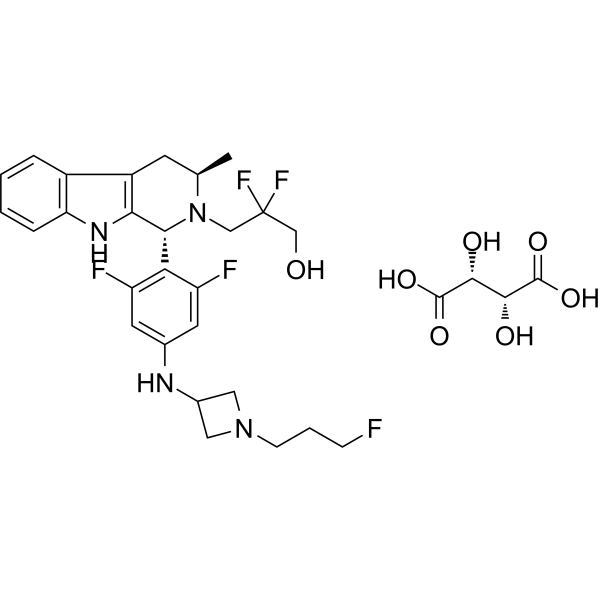
-
- HY-A0038
-
|
CP-336156 tartrate
|
Estrogen Receptor/ERR
|
Endocrinology
Cancer
|
|
Lasofoxifene (CP-336156) tartrate is an orally active and selective estrogen receptor modulator (SERM) . Lasofoxifene tartrate exhibits an anti-osteoporotic function and also inhibits primary tumor growth and metastases. Lasofoxifene tartrate can be used for the research of breast cancer and postmenopausal osteoporosis .
|
-
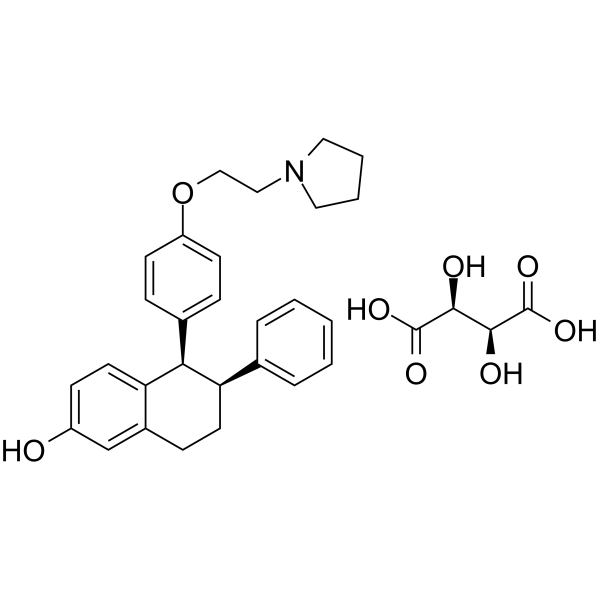
-
- HY-114154
-
|
|
Glucocorticoid Receptor
|
Inflammation/Immunology
|
|
AL-438 is a potent, selective and orally active glucocorticoid receptor modulator with Kis of 2.5, 1786, 53, 1440, >1000 nM for glucocorticoid receptor, progesterone receptor, mineralocorticoid receptor, androgen receptor, estrogen receptor, respectively. AL-438 shows antiinflammatory activity .
|
-
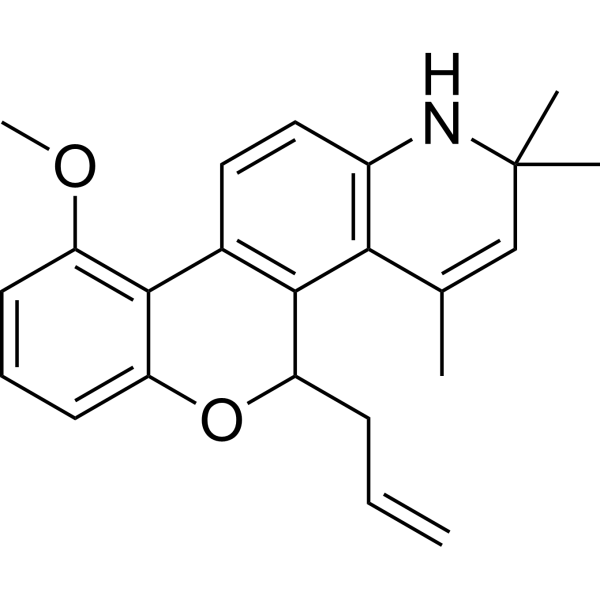
-
- HY-16950
-
|
(Z)-4-Hydroxytamoxifen; trans-4-Hydroxytamoxifen; (Z)-Afimoxifene
|
Estrogen Receptor/ERR
|
Cancer
|
|
4-Hydroxytamoxifen ((Z)-4-Hydroxytamoxifen) is an orally active, selective estrogen receptor modulator (SERM). 4-Hydroxytamoxifen ((Z)-4-Hydroxytamoxifen) induces CRISPR/Cas9 systems based on ER mediated nucleus translocation .
|
-

-
- HY-16950BS
-
|
(E)-Afimoxifene-d5
|
Isotope-Labeled Compounds
Estrogen Receptor/ERR
|
Cancer
|
|
(E)-4-Hydroxytamoxifen-d5 ((E)-Afimoxifene-d5) is the deuterium labeled (E)-4-Hydroxytamoxifen. (E)-4-Hydroxytamoxifen ((E)-Afimoxifene), the less active isomer of (Z)-4-hydroxytamoxifen, is an estrogen receptor modulator.
|
-
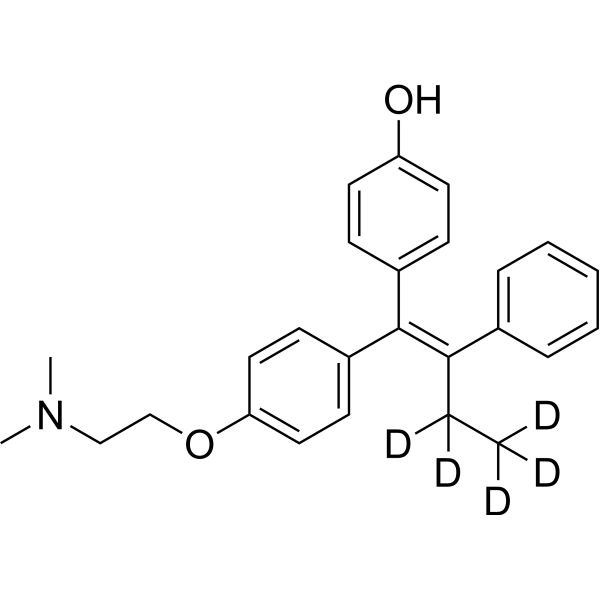
- HY-16023A
-
|
EM-652; SCH 57068
|
Estrogen Receptor/ERR
|
Cancer
|
|
Acolbifene (EM-652), the active metabolite of EM800, is an orally active pure antiestrogen and selective estrogen receptor antagonist. Acolbifene (EM-652) inhibits estradiol (E2)-induced transcriptional activity of ERα (IC50 = 2 nM) and ERβ (IC50 = 0.4 nM). Acolbifene (EM-652) possesses potent and pure anticarcinogenic properties .
|
-
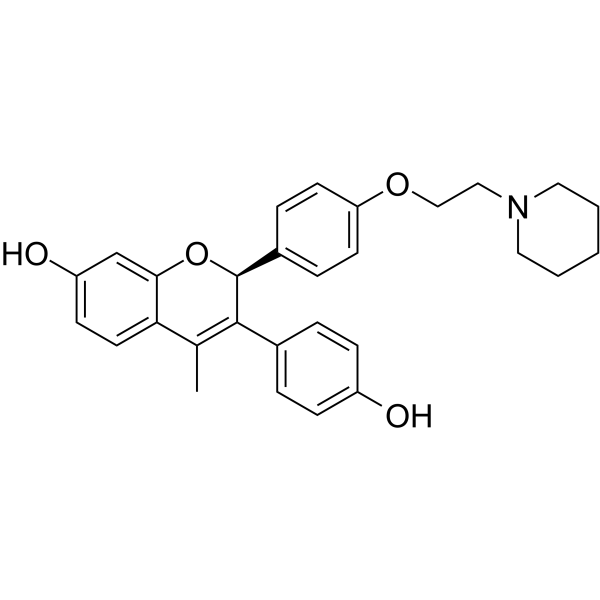
- HY-B0251S
-
|
Epoxymexrenone-d3
|
Mineralocorticoid Receptor
Endogenous Metabolite
|
Cardiovascular Disease
|
|
Eplerenone-d3 is the deuterium labeled Eplerenone. Eplerenone (Epoxymexrenone) is a selective, competitive and oreally active aldosterone antagonist with an IC50 of 138 nM. Eplerenone has low affinity for progesterone, androgen, estrogen and glucocorticoid receptors. Eplerenone can be used for hypertension and heart failure after myocardial infarction reserch[1][2].
|
-

- HY-144656
-
|
|
Steroid Sulfatase
|
Cancer
|
|
Steroid sulfatase-IN-1 is a potent and orally active Steroid sulfatase inhibitor with an IC50 of 1.71 nM. Steroid sulfatase-IN-1 shows antitumor activity in vivo. Steroid sulfatase-IN-1 has the potential for the research of breast cancer .
|
-

- HY-14248S
-
|
|
Isotope-Labeled Compounds
Cytochrome P450
Autophagy
|
Cancer
|
|
Letrozole-d4 (CGS 20267-d4) is the deuterium labeled Letrozole. Letrozole (CGS 20267) is a potent, selective, reversible and orally active non-steroidal inhibitor of aromatase, with an IC50 of 11.5 nM. Letrozole selective inhibits estrogen biosynthesis, and can be used for the research of breast cancer[1][2][3].
|
-
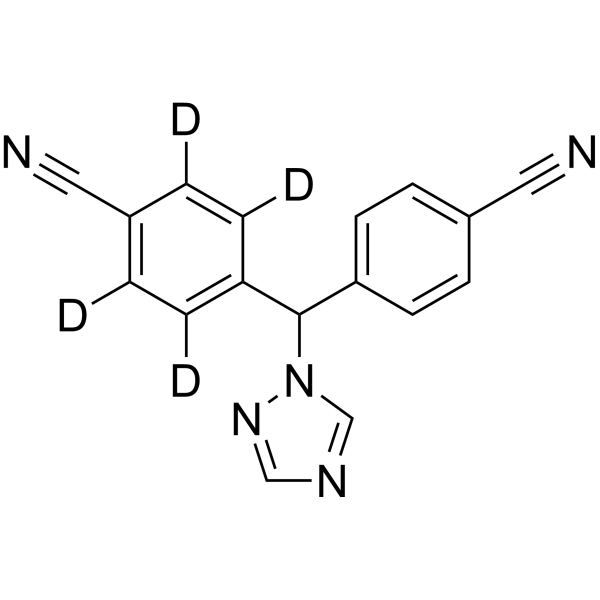
- HY-133017
-
|
SAR439859
|
Estrogen Receptor/ERR
|
Cancer
|
|
SAR439859 (compound 43d) is an orally active, nonsteroidal and selective estrogen receptor degrader (SERD). SAR439859 is a potent ER antagonist and has ER degrading activity with an EC50 of 0.2 nM for ERα degradation . SAR439859 demonstrates robust antitumor efficacy and limited cross-resistance in ER + breast cancer .
|
-
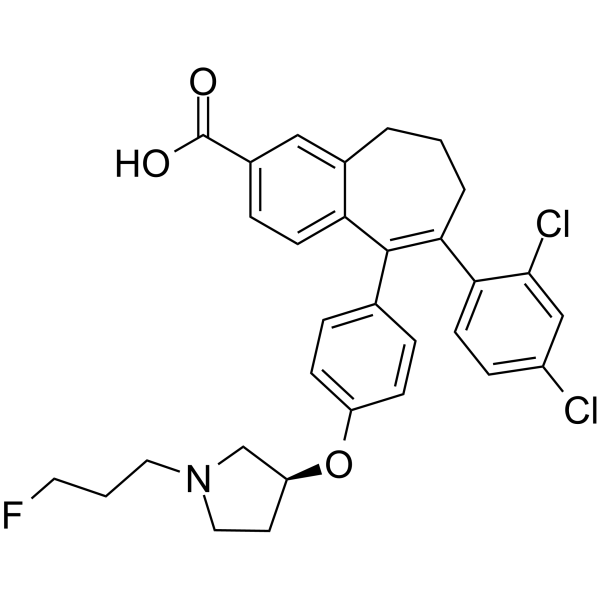
- HY-135671
-
|
|
Aryl Hydrocarbon Receptor
VEGFR
Estrogen Receptor/ERR
|
Endocrinology
Cancer
|
|
AhR modulator-1 (compound 6-MCDF) is a selective and orally active aryl hydrocarbon receptor (AhR) modulator. AhR modulator-1 inhibits metastasis, in part, by inhibiting prostatic VEGF production prior to tumor formation. AhR modulator-1 also possess anti-estrogenic properties in rat uterus .
|
-
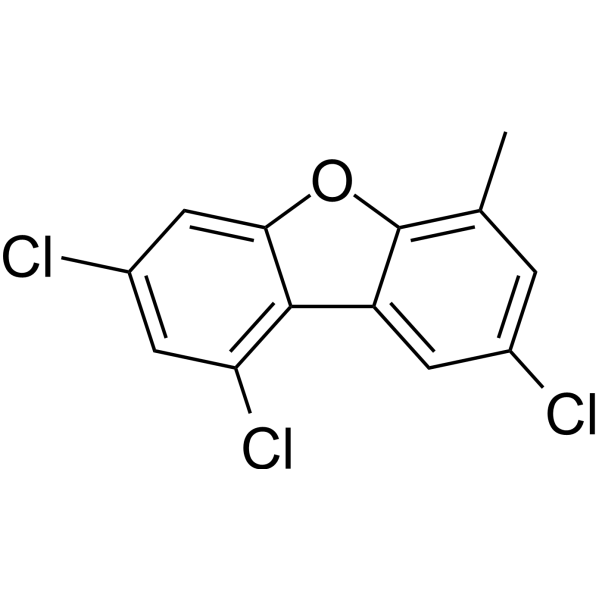
- HY-111226
-
GSK5182
2 Publications Verification
|
Estrogen Receptor/ERR
Reactive Oxygen Species
|
Cardiovascular Disease
Cancer
|
|
GSK5182 is a highly selective and orally active inverse agonist of estrogen-related receptor γ (ERRγ) with an IC50 of 79 nM. GSK5182 does not interact with other nuclear receptors, including ERRα or ERα. GSK5182 also induces reactive oxyen species (ROS) generation in hepatocellular carcinoma (HCC) .
|
-

- HY-145572
-
|
LY-3484356
|
Estrogen Receptor/ERR
|
Cancer
|
|
Imlunestrant (LY-3484356) is an orally active, potent and selective estrogen receptor degrader (SERD) with pure antagonistic properties. Imlunestrant results in sustained inhibition of ER-dependent gene transcription and cell growth. Imlunestrant can be used for the research of ER-positive (ER+) advanced breast cancer (aBC) and endometrial endometrioid cancer (EEC) .
|
-
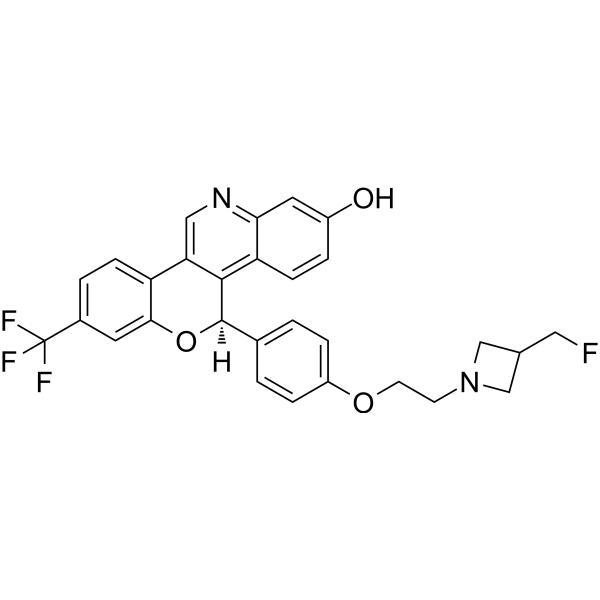
- HY-145572A
-
|
LY-3484356 tosylate
|
Estrogen Receptor/ERR
|
Cancer
|
|
Imlunestrant (LY-3484356) tosylate is an orally active, potent and selective estrogen receptor degrader (SERD) with pure antagonistic properties. Imlunestrant tosylate results in sustained inhibition of ER-dependent gene transcription and cell growth. Imlunestrant tosylate can be used for the research of ER-positive (ER+) advanced breast cancer (aBC) and endometrial endometrioid cancer (EEC) .
|
-
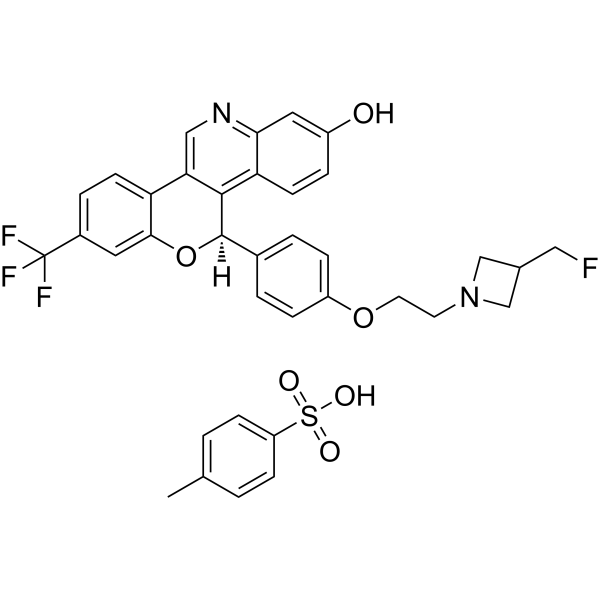
- HY-B0390
-
|
|
Estrogen Receptor/ERR
|
Endocrinology
Cancer
|
|
Mestranol is an inactive proagent and becomes biologically active on conversion to ethinyl estradiol (EE). Mestranol acts as an estrogen receptor agonist. Mestranol combines with a progestin in vivo and can be used for the research of menopausal hormone or menstrual disorders. Mestranol is a click chemistry reagent, it contains an Alkyne group and can undergo copper-catalyzed azide-alkyne cycloaddition (CuAAc) with molecules containing Azide groups.
|
-
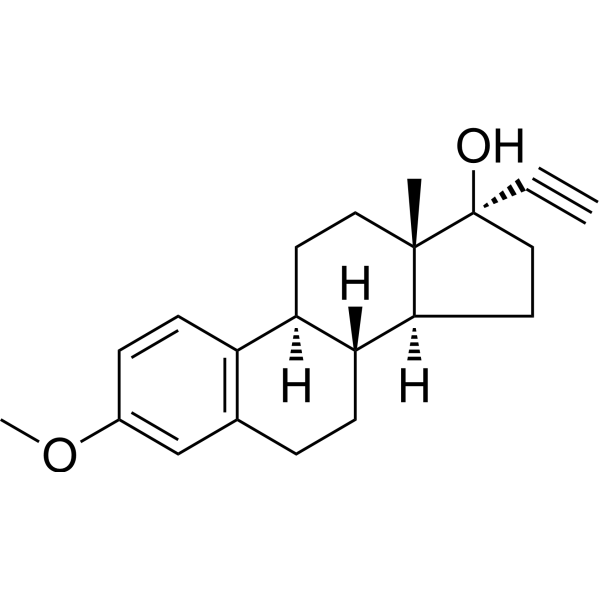
- HY-16023
-
|
EM-652 hydrochloride; SCH 57068 hydrochloride
|
Estrogen Receptor/ERR
|
Cancer
|
|
Acolbifene (EM-652) hydrochloride, an active metabolite of EM800, is an orally active, cancer-preventing selective estrogen receptor modulator (SERM). Acolbifene (EM-652) hydrochloride inhibits estradiol (E2)-induced transcriptional activity of ERα (IC50=2 nM) and ERβ (IC50=0.4 nM). Acolbifene (EM-652) hydrochloride exerts a potent and pure antiestrogenic action in the mammary gland and uterus. Anticarcinogenic properties .
|
-
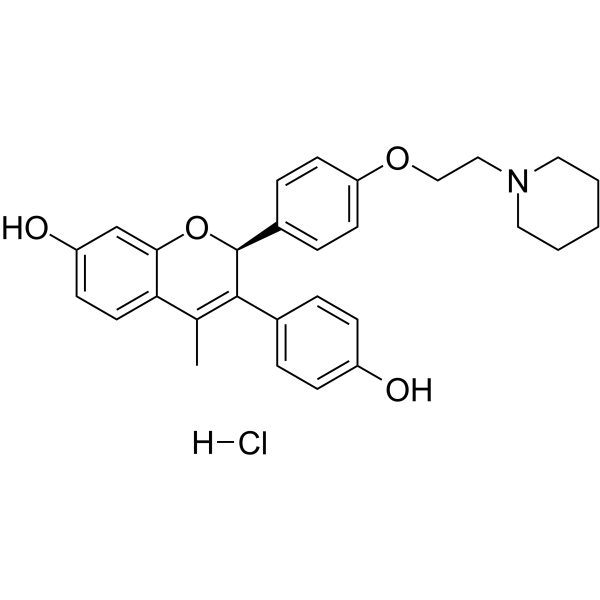
- HY-B0900
-
|
Anise camphor; p-Propenylanisole; Isoestragole
|
Apoptosis
Fungal
Bacterial
MMP
NF-κB
|
Infection
Neurological Disease
Inflammation/Immunology
Cancer
|
|
Anethole is a type of orally active aromatic compound that is widely found in nature and used as a flavoring agent. Anethole possesses anticancer, anti-inflammatory, antioxidant, antibacterial, antifungal, anesthetic, estrogenic, central nervous system depressant, hypnotic, insecticidal, and gastroprotective effects. Anethole can be used in the study of oxidative stress-related skin diseases and prostate cancer .
|
-
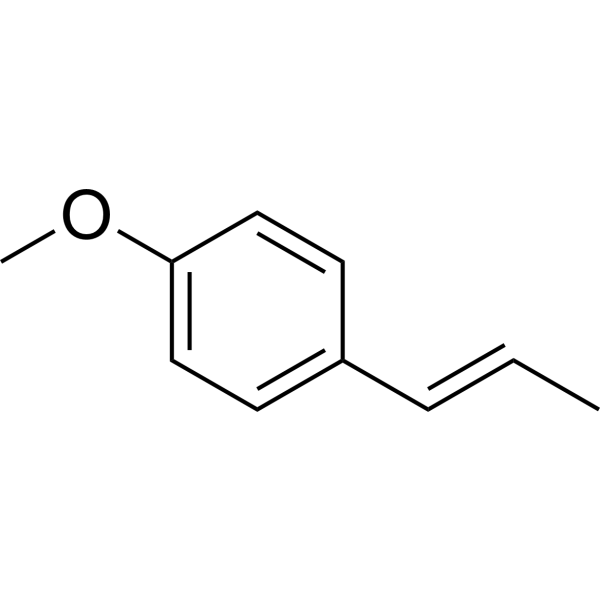
- HY-111226A
-
|
|
Estrogen Receptor/ERR
Reactive Oxygen Species
|
Cardiovascular Disease
Cancer
|
|
(E/Z)-GSK5182 is a racemic compound of (E)-GSK5182 and (Z)-GSK5182 isomers. GSK5182 is a highly selective and orally active inverse agonist of estrogen-related receptor γ (ERRγ) with an IC50 of 79 nM . GSK5182 also induces reactive oxyen species (ROS) generation in hepatocellular carcinoma .
|
-
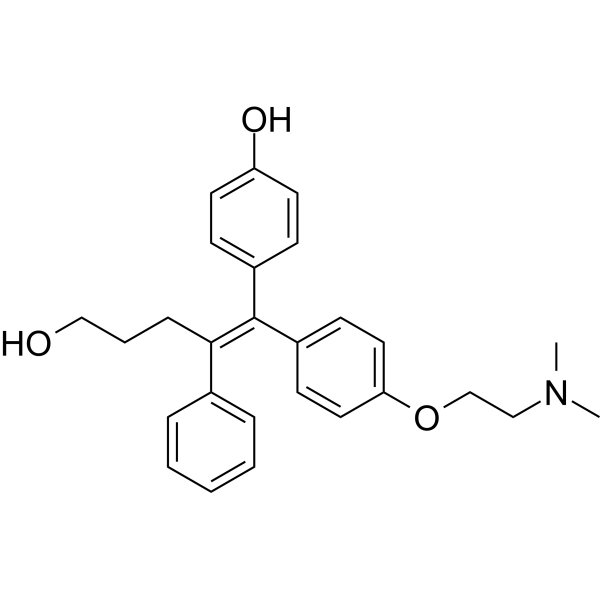
- HY-143439
-
|
|
Estrogen Receptor/ERR
|
Cancer
|
|
LX-039 is a highly potent, selective and orally active estrogen receptor degrader with EC50 value of 2.29 nM. LX-039 has indole C-3 chlorine atom. LX-039 exhibits excellent mouse pharmacokinetics, low clearance, high Cmax and oral exposure. LX-039 has anti-tumor activity .
|
-
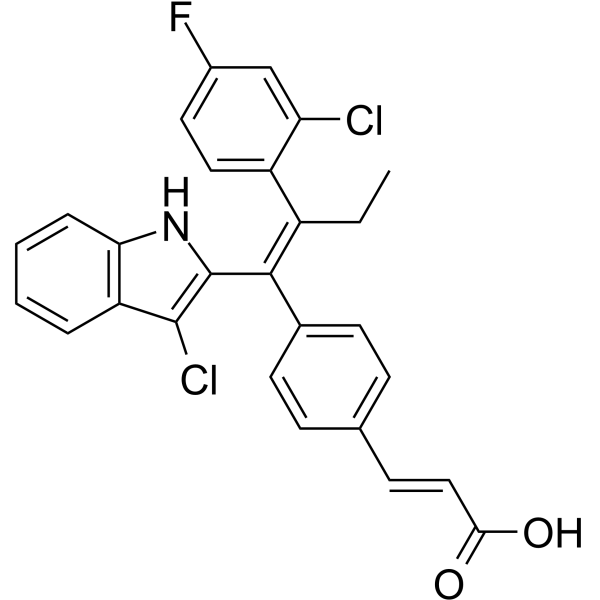
- HY-A0031A
-
|
TSE-424 hydrochloride
|
Estrogen Receptor/ERR
|
Cancer
|
|
Bazedoxifene hydrochloride (TSE-424 hydrochloride) is an oral active, BBB-penetrant nonsteroidal selective estrogen receptor modulator (SERM), with IC50s of 23 nM and 99 nM for ERα and ERβ, respectively. Bazedoxifene hydrochloride can be used for the research of osteoporosis. Bazedoxifene hydrochloride acts as an inhibitor of IL-6/GP130 protein-protein interactions. Bazedoxifene hydrochloride can be used for the research of pancreatic cancer .
|
-
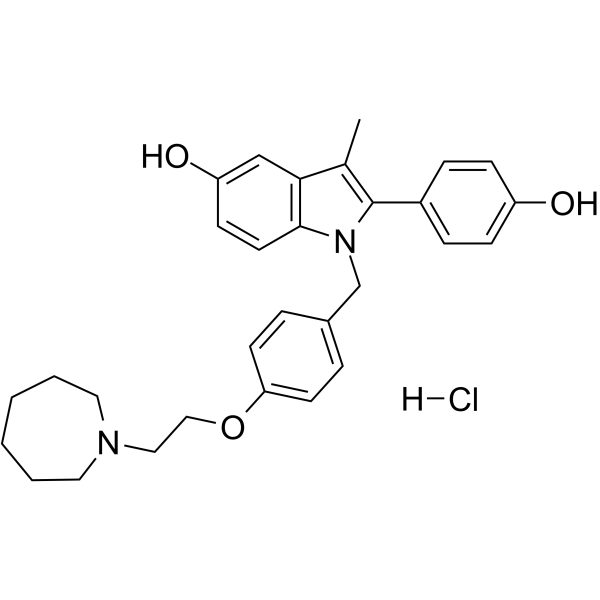
- HY-B0216S
-
|
17α-Ethynylestradiol-d4; Ethynylestradiol-d4
|
Estrogen Receptor/ERR
Endogenous Metabolite
|
Endocrinology
Cancer
|
|
Ethynyl Estradiol-d4 is the deuterium labeled Ethynyl Estradiol. Ethynyl Estradiol (17α-Ethynylestradiol;Ethynylestradiol) is an orally bio-active estrogen used in almost all modern formulations of combined oral contraceptive pills. Ethynyl Estradiol-d4 is a click chemistry reagent, it contains an Alkyne group and can undergo copper-catalyzed azide-alkyne cycloaddition (CuAAc) with molecules containing Azide groups.
|
-

- HY-135594
-
|
|
Estrogen Receptor/ERR
|
Metabolic Disease
|
|
4'-Raloxifene-β-D-glucopyranoside, a metabolite of Raloxifene, is a benzothiophene glucuronidated at the 4' postion. 4'-Raloxifene-β-D-glucopyranoside is a selective and orally active estrogen receptor antagonist. 4'-Raloxifene-β-D-glucopyranoside can be used for inhibiting bone loss and resorption, and lowering lipid levels. 4'-Raloxifene-β-D-glucopyranoside, example 5, is extracted from patent US5567820A .
|
-
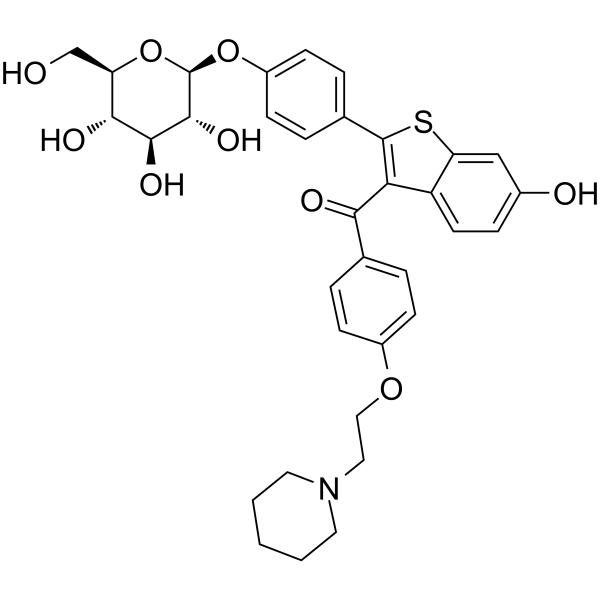
- HY-135595
-
|
|
Estrogen Receptor/ERR
Drug Metabolite
|
Metabolic Disease
|
|
6-Raloxifene-β-D-glucopyranoside, a derivative of Raloxifene, is a benzothiophene glucuronidated at the 6' postion. 6-Raloxifene-β-D-glucopyranoside is a selective and orally active estrogen receptor antagonist. 6-Raloxifene-β-D-glucopyranoside can be used for inhibiting bone loss and resorption, and lowering lipid levels. 6'-Raloxifene-β-D-glucopyranoside, compound Ia, is extracted from patent US5567820A .
|
-
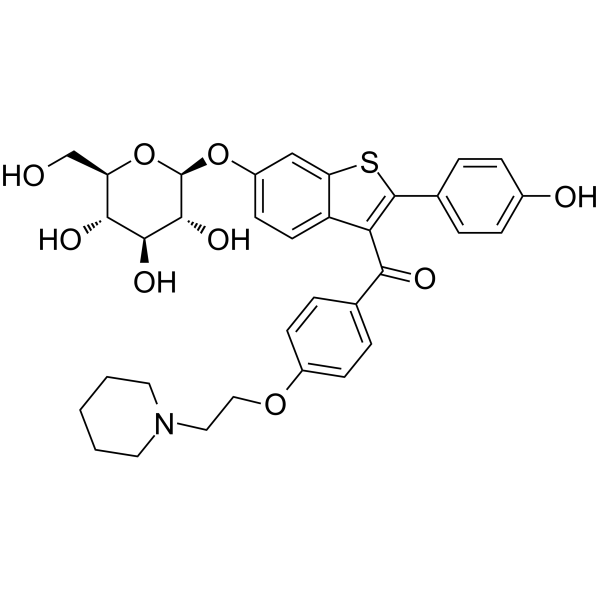
- HY-105118A
-
|
CGS-9343B; KW 5617
|
Calmodulin
|
Neurological Disease
Metabolic Disease
Inflammation/Immunology
|
|
Zaldaride maleate (CGS-9343B) is a potent, orally active and selective inhibitor of calmodulin. Zaldaride maleate (CGS-9343B) inhibits CaM (calmodulin)-stimulated cAMP phosphodiesterase activity, with an IC50 of 3.3 nM . Zaldaride maleate (CGS-9343B) prevents estrogen-induced transcription activation by ER, reversibly blocks voltage-activated Na +, Ca 2+ and K + currents in PC12 cells and inhibits nAChR .
|
-

- HY-B0390S
-
|
|
Isotope-Labeled Compounds
Estrogen Receptor/ERR
|
Cancer
|
|
Mestranol-d2 is the deuterium labeled Mestranol. Mestranol is an inactive proagent and becomes biologically active on conversion to ethinyl estradiol (EE). Mestranol acts as an estrogen receptor agonist. Mestranol combines with a progestin in vivo and can be used for the research of menopausal hormone or menstrual disorders[1][2][3]. Mestranol-d2 is a click chemistry reagent, it contains an Alkyne group and can undergo copper-catalyzed azide-alkyne cycloaddition (CuAAc) with molecules containing Azide groups.
|
-
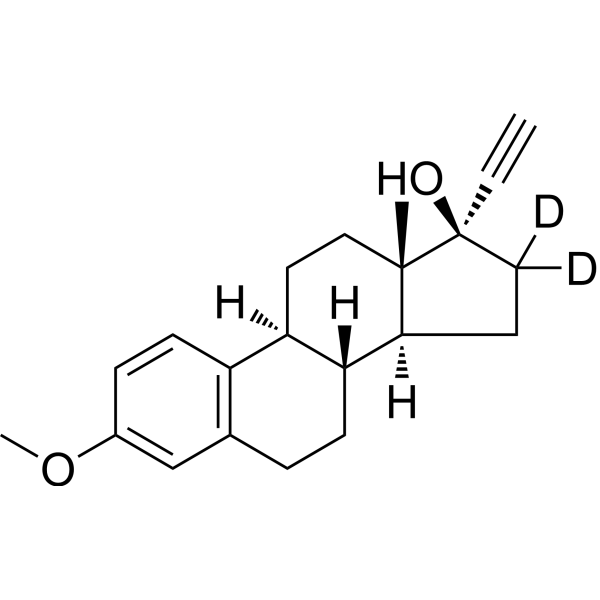
- HY-B0390S1
-
|
|
Isotope-Labeled Compounds
Estrogen Receptor/ERR
|
|
|
Mestranol-d4 is the deuterium labeled Mestranol. Mestranol is an inactive proagent and becomes biologically active on conversion to ethinyl estradiol (EE). Mestranol acts as an estrogen receptor agonist. Mestranol combines with a progestin in vivo and can be used for the research of menopausal hormone or menstrual disorders[1][2][3]. Mestranol-d4 is a click chemistry reagent, it contains an Alkyne group and can undergo copper-catalyzed azide-alkyne cycloaddition (CuAAc) with molecules containing Azide groups.
|
-
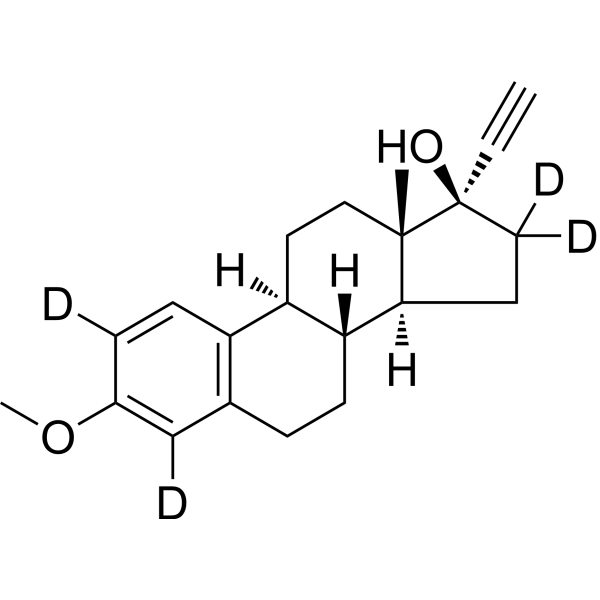
- HY-112611
-
|
|
Estrogen Receptor/ERR
|
Cancer
|
|
H3B-5942 is a selective, irreversible and orally active estrogen receptor covalent antagonist, inactivates both wild-type and mutant ERα by targeting Cys530, with Kis of 1 nM and 0.41 nM, respectively. H3B-5942 reduces ERα target gene GREB1, shows potent antitumor activity both in multiple cell lines or animals bearing ERα WT or ERα mutations .
|
-
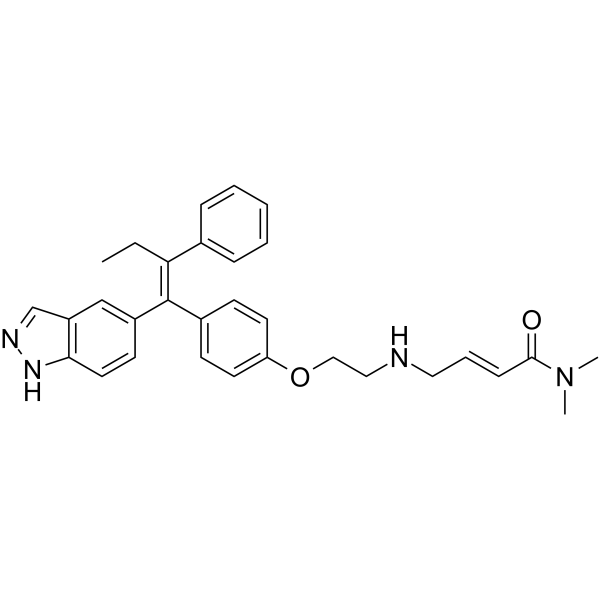
| Cat. No. |
Product Name |
Category |
Target |
Chemical Structure |
-
- HY-B0216
-
-

-
- HY-13738A
-
-

-
- HY-113293B
-
-

-
- HY-W587691
-
-

-
- HY-13738AR
-
-

-
- HY-B0412
-
-

-
- HY-14248
-
-

-
- HY-B0900
-
|
Anise camphor; p-Propenylanisole; Isoestragole
|
Structural Classification
Classification of Application Fields
Callicarpa maingayi King & Gamble
Source classification
Plants
Microorganisms
Simple Phenylpropanols
Leguminosae
Phenylpropanoids
Umbelliferae
Glycyrrhiza uralensis Fisch.
Disease Research Fields
Cancer
|
Apoptosis
Fungal
Bacterial
MMP
NF-κB
|
|
Anethole is a type of orally active aromatic compound that is widely found in nature and used as a flavoring agent. Anethole possesses anticancer, anti-inflammatory, antioxidant, antibacterial, antifungal, anesthetic, estrogenic, central nervous system depressant, hypnotic, insecticidal, and gastroprotective effects. Anethole can be used in the study of oxidative stress-related skin diseases and prostate cancer .
|
-

| Cat. No. |
Product Name |
Chemical Structure |
-
- HY-113293BS1
-
|
|
|
Estrone sulfate-d4 (sodium) is deuterium labeled Estrone sulfate (sodium). Estrone sulfate, a biologically inactive form of estrogen, is a major circulating plasma estrogen that is converted into the biologically active estrogen, estrone (E1) by steroid sulfatase (STS). strone sulfate can be used for the research of breast cancer[1][2].
|
-

-
- HY-113293BS
-
|
|
|
Estrone sulfate-d5 (sodium) is the deuterium labeled Estrone sulfate sodium. Estrone sulfate, a biologically inactive form of estrogen, is a major circulating plasma estrogen that is converted into the biologically active estrogen, estrone (E1) by steroid sulfatase (STS). strone sulfate can be used for the research of breast cancer[1][2].
|
-

-
- HY-B2158S
-
|
|
|
Chlorotrianisene-d9 is the deuterium labeled Chlorotrianisene. Chlorotrianisene is a long-acting non-steroidal estrogen and an orally active estrogen receptor modulator. Chlorotrianisene exhibits antiestrogenic activity. Chlorotrianisene potently inhibits the enzyme COX-1 and inhibits platelet aggregation in whole blood[1][2][3].
|
-

-
- HY-B0723S
-
|
|
|
Ospemifene-d4 is a deuterium labeled Ospemifene. Ospemifene is a selective and orally active estrogen receptor modulator for the prevention of osteoporosis with IC50 values of 827 nM and 1633 nM for estrogen receptor α (ERα) and ERβ, respectively. Ospemifene has bone-sparing, antitumor, and cholesterol-lowering effects[1][2].
|
-

-
- HY-18719ES
-
|
|
|
Endoxifen-d5 is the deuterium labeled Endoxifen. Endoxifen is a key active metabolite of tamoxifen (TAM) with higher affinity and specificity to estrogen receptor that also inhibits aromatase activity. Endoxifen has the potential for breast cancer study[1][2].
|
-

-
- HY-13757AS
-
|
|
|
Tamoxifen-d5 is a deuterium labeled Tamoxifen. Tamoxifen (ICI 47699) is an orally active, selective estrogen receptor modulator (SERM). Tamoxifen is a potent Hsp90 activator and enhances the Hsp90 molecular chaperone ATPase activity[1][2].
|
-

-
- HY-13757AS1
-
|
|
|
Tamoxifen-d3 is the deuterium labeled Tamoxifen[1]. Tamoxifen (ICI 47699) is an orally active, selective estrogen receptor modulator (SERM) which blocks estrogen action in breast cells and can activate estrogen activity in other cells, such as bone, liver, and uterine cells[2][3][4]. Tamoxifen is a potent Hsp90 activator and enhances the Hsp90 molecular chaperone ATPase activity. Tamoxifen also potent inhibits infectious EBOV Zaire and Marburg (MARV) with IC50 of 0.1 μM and 1.8 μM, respectively[6]. Tamoxifen activates autophagy and induces apoptosis[5]. Tamoxifen also can induce gene knockout of CreER(T2) transgenic mouse[7].
|
-

-
- HY-16950BS
-
|
|
|
(E)-4-Hydroxytamoxifen-d5 ((E)-Afimoxifene-d5) is the deuterium labeled (E)-4-Hydroxytamoxifen. (E)-4-Hydroxytamoxifen ((E)-Afimoxifene), the less active isomer of (Z)-4-hydroxytamoxifen, is an estrogen receptor modulator.
|
-

-
- HY-B0251S
-
|
|
|
Eplerenone-d3 is the deuterium labeled Eplerenone. Eplerenone (Epoxymexrenone) is a selective, competitive and oreally active aldosterone antagonist with an IC50 of 138 nM. Eplerenone has low affinity for progesterone, androgen, estrogen and glucocorticoid receptors. Eplerenone can be used for hypertension and heart failure after myocardial infarction reserch[1][2].
|
-

-
- HY-14248S
-
|
|
|
Letrozole-d4 (CGS 20267-d4) is the deuterium labeled Letrozole. Letrozole (CGS 20267) is a potent, selective, reversible and orally active non-steroidal inhibitor of aromatase, with an IC50 of 11.5 nM. Letrozole selective inhibits estrogen biosynthesis, and can be used for the research of breast cancer[1][2][3].
|
-

-
- HY-B0216S
-
|
|
|
Ethynyl Estradiol-d4 is the deuterium labeled Ethynyl Estradiol. Ethynyl Estradiol (17α-Ethynylestradiol;Ethynylestradiol) is an orally bio-active estrogen used in almost all modern formulations of combined oral contraceptive pills. Ethynyl Estradiol-d4 is a click chemistry reagent, it contains an Alkyne group and can undergo copper-catalyzed azide-alkyne cycloaddition (CuAAc) with molecules containing Azide groups.
|
-

-
- HY-B0390S
-
|
|
|
Mestranol-d2 is the deuterium labeled Mestranol. Mestranol is an inactive proagent and becomes biologically active on conversion to ethinyl estradiol (EE). Mestranol acts as an estrogen receptor agonist. Mestranol combines with a progestin in vivo and can be used for the research of menopausal hormone or menstrual disorders[1][2][3]. Mestranol-d2 is a click chemistry reagent, it contains an Alkyne group and can undergo copper-catalyzed azide-alkyne cycloaddition (CuAAc) with molecules containing Azide groups.
|
-

-
- HY-B0390S1
-
|
|
|
Mestranol-d4 is the deuterium labeled Mestranol. Mestranol is an inactive proagent and becomes biologically active on conversion to ethinyl estradiol (EE). Mestranol acts as an estrogen receptor agonist. Mestranol combines with a progestin in vivo and can be used for the research of menopausal hormone or menstrual disorders[1][2][3]. Mestranol-d4 is a click chemistry reagent, it contains an Alkyne group and can undergo copper-catalyzed azide-alkyne cycloaddition (CuAAc) with molecules containing Azide groups.
|
-

| Cat. No. |
Product Name |
|
Classification |
-
- HY-B0216
-
|
Ethynyl estradiol; 17α-Ethynylestradiol
|
|
Alkynes
|
|
Ethinylestradiol is an orally active steroidal estrogen. Ethinylestradiol is widely used in research on menopausal symptoms, gynecological conditions, and certain hormone-sensitive cancers .
|
-
- HY-B0390
-
|
|
|
Alkynes
|
|
Mestranol is an inactive proagent and becomes biologically active on conversion to ethinyl estradiol (EE). Mestranol acts as an estrogen receptor agonist. Mestranol combines with a progestin in vivo and can be used for the research of menopausal hormone or menstrual disorders. Mestranol is a click chemistry reagent, it contains an Alkyne group and can undergo copper-catalyzed azide-alkyne cycloaddition (CuAAc) with molecules containing Azide groups.
|
-
- HY-B0216S
-
|
17α-Ethynylestradiol-d4; Ethynylestradiol-d4
|
|
Alkynes
|
|
Ethynyl Estradiol-d4 is the deuterium labeled Ethynyl Estradiol. Ethynyl Estradiol (17α-Ethynylestradiol;Ethynylestradiol) is an orally bio-active estrogen used in almost all modern formulations of combined oral contraceptive pills. Ethynyl Estradiol-d4 is a click chemistry reagent, it contains an Alkyne group and can undergo copper-catalyzed azide-alkyne cycloaddition (CuAAc) with molecules containing Azide groups.
|
-
- HY-B0390S
-
|
|
|
Alkynes
|
|
Mestranol-d2 is the deuterium labeled Mestranol. Mestranol is an inactive proagent and becomes biologically active on conversion to ethinyl estradiol (EE). Mestranol acts as an estrogen receptor agonist. Mestranol combines with a progestin in vivo and can be used for the research of menopausal hormone or menstrual disorders[1][2][3]. Mestranol-d2 is a click chemistry reagent, it contains an Alkyne group and can undergo copper-catalyzed azide-alkyne cycloaddition (CuAAc) with molecules containing Azide groups.
|
-
- HY-B0390S1
-
|
|
|
Alkynes
|
|
Mestranol-d4 is the deuterium labeled Mestranol. Mestranol is an inactive proagent and becomes biologically active on conversion to ethinyl estradiol (EE). Mestranol acts as an estrogen receptor agonist. Mestranol combines with a progestin in vivo and can be used for the research of menopausal hormone or menstrual disorders[1][2][3]. Mestranol-d4 is a click chemistry reagent, it contains an Alkyne group and can undergo copper-catalyzed azide-alkyne cycloaddition (CuAAc) with molecules containing Azide groups.
|
Your information is safe with us. * Required Fields.
Inquiry Information
- Product Name:
- Cat. No.:
- Quantity:
- MCE Japan Authorized Agent:
















































































